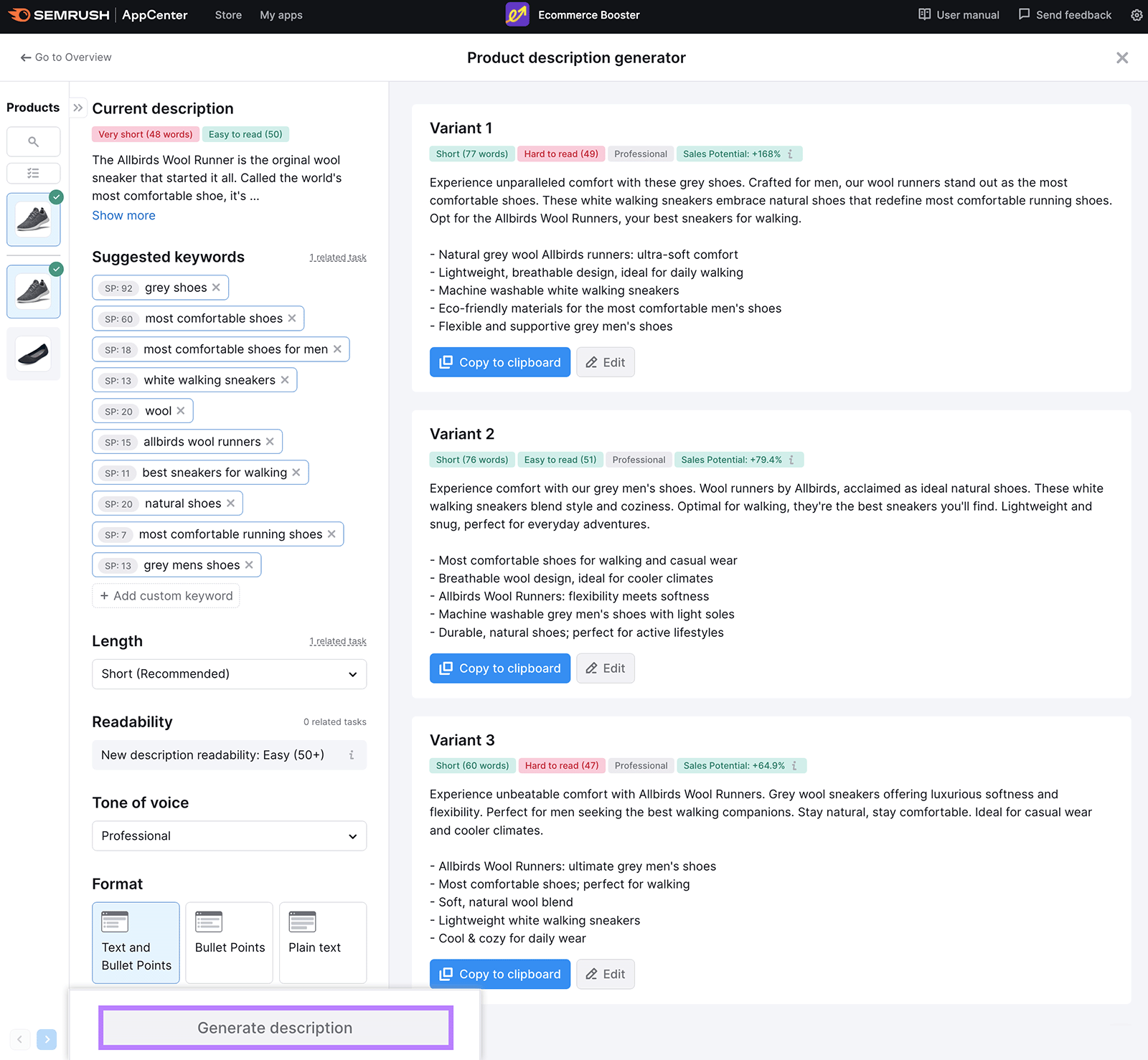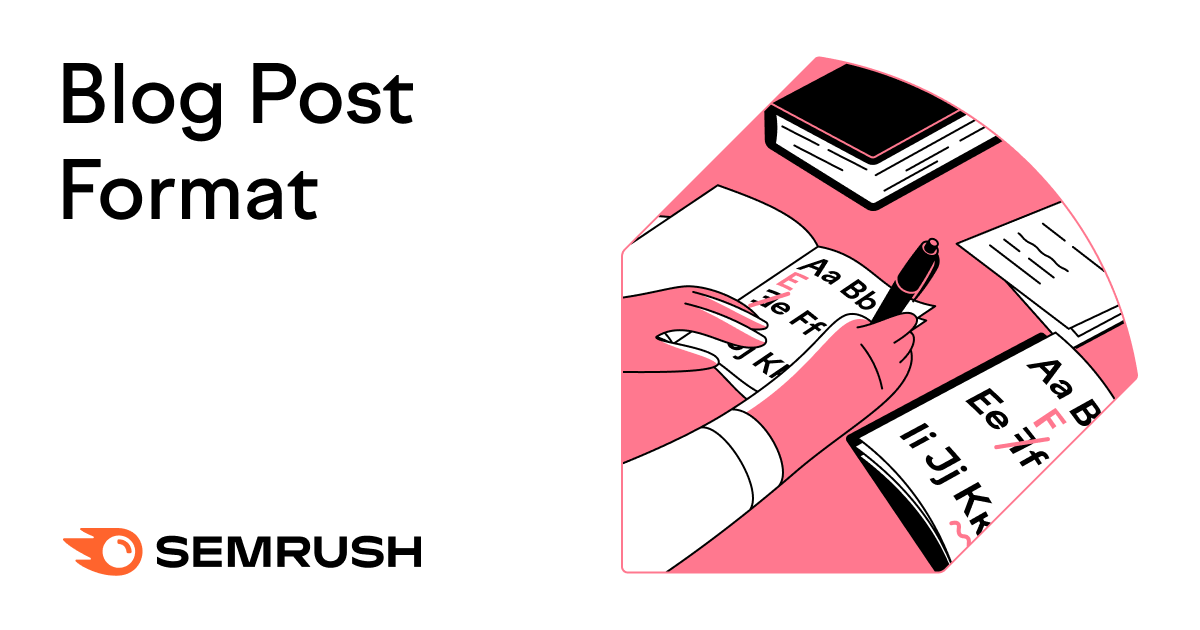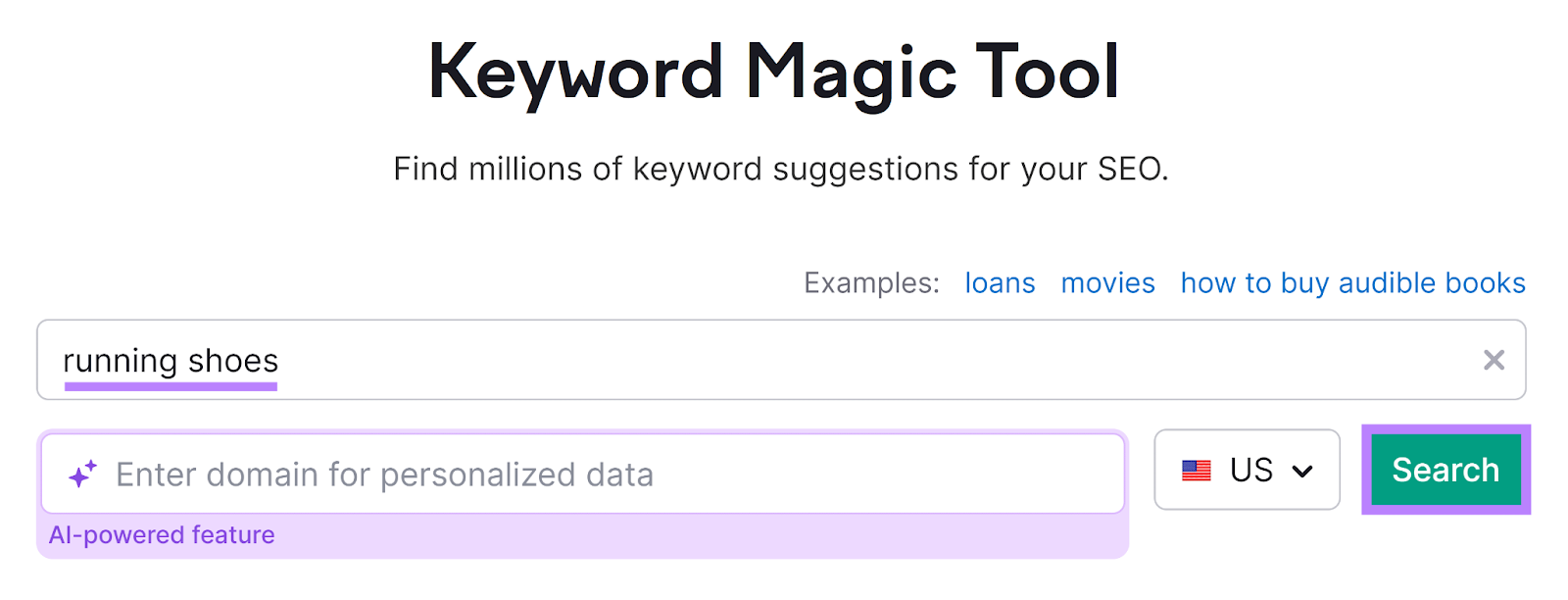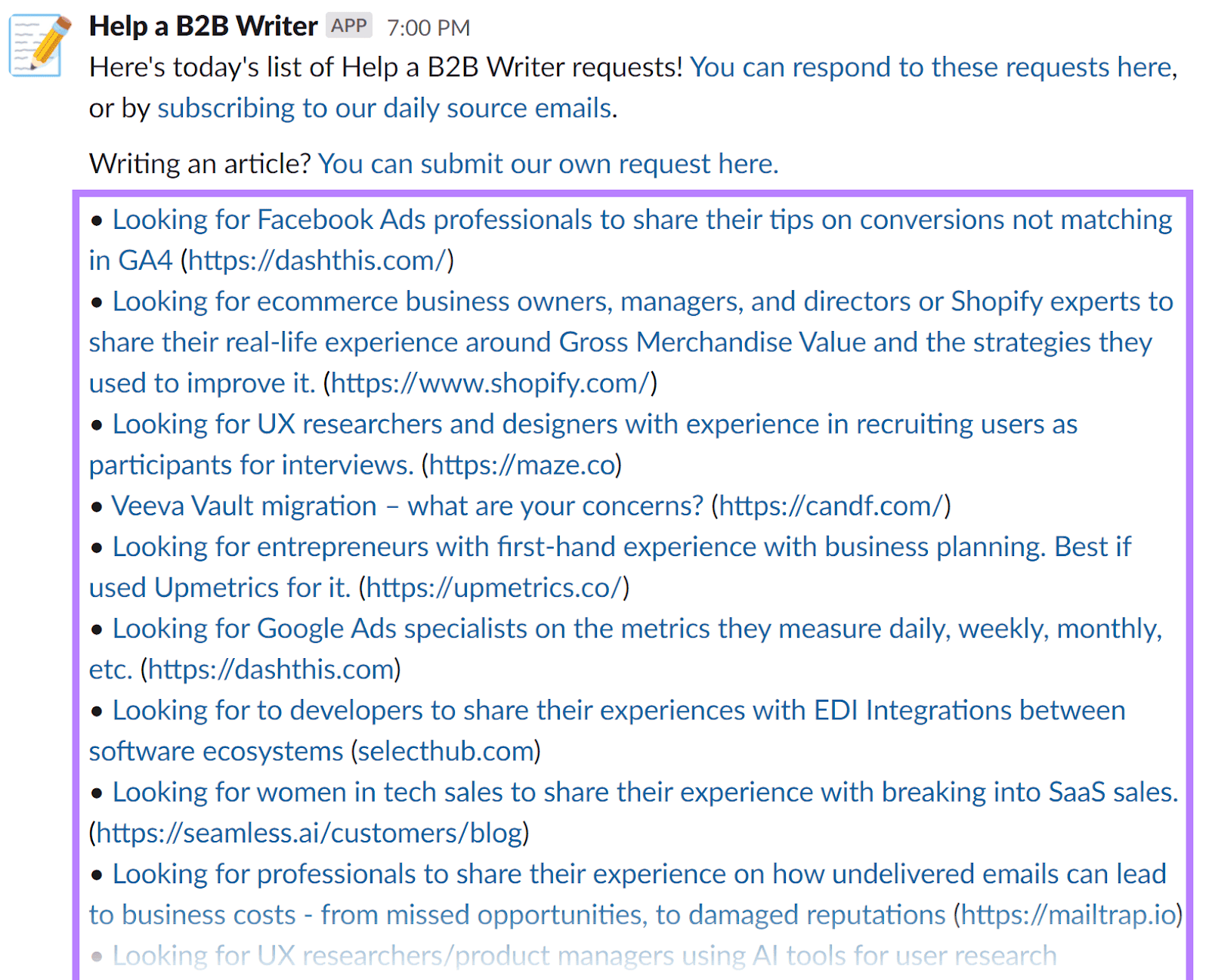What Is Generative AI (Artificial Intelligence)?
Generative AI refers to technology that uses machine learning models to create content. Machine learning models are computer programs that seek to replicate aspects of human intelligence.
These models can produce various content formats, including code, text, visuals, audio, and video.
Various programs have the ability to learn almost any kind of information. For example, different generative AI models can understand coding, visual, scientific, and human languages.
OpenAI’s ChatGPT is a popular example of a model that understands and produces textual content. In this article, we’ll explore how this and other gen AI tools work.
How Generative AI Works
Gen AI uses libraries of existing material to produce original content. Here’s how the process works.
First, Users Provide Prompts
The technology generates content based on user prompts. Depending on the tool you use, you may be able to enter freeform, text-based prompts.
Suppose you want to generate a description for a new ecommerce item. A simple ChatGPT prompt could look like this:
Write a 100-word product description for [insert product details]. Use a friendly, upbeat tone of voice.
Some AI tools use parameters rather than freeform input.
For example, Semrush’s Ecommerce Booster app generates ad descriptions based on keywords, text length, readability, tone of voice, and format settings.
Then, Generative AI Models Produce Content
Once the system receives the user’s prompt, it uses machine learning models to generate content. These models train using libraries that may contain billions of pieces of existing content.
As they train, the models learn the components and structures of this existing content. Then, they use what they’ve learned to generate similar, original material.
The mechanics of the content generation process vary, depending on the type of output. Some of the most common models include:
- Large Language Models (LLMs): Algorithms that use large data sets to predict the next output (word) in a piece of content—typically used to generate textual content
- Generative Adversarial Networks (GANs): Deep learning systems that use two competing neural networks to produce new output, mostly for visual or audio content generation
- Variational Autoencoders (VAEs): Neural network systems that encode and decode input to create new output, often to generate visual or code content
Gen AI vs. Other Types of AI
The standard generative AI meaning doesn’t include all types of artificial intelligence. Unlike gen AI, so-called “normal” AI analyzes and synthesizes data rather than generate new output.
Here are two other types of AI:
- Conversational AI: Uses natural language processing (NLP) techniques to analyze human language, understand what users are saying or typing, and provide relevant responses. This type of AI is most common in chatbots and AI assistants.
- Predictive AI: Analyzes historical data to anticipate outcomes from specific events and suggest actionable steps. This kind of AI is common with data analysts who need to manage risk and make data-driven decisions.
Now that we’ve covered a comprehensive generative AI definition, let’s take a closer look at some of the most widely used gen AI tools.
ChatGPT
ChatGPT is an AI chatbot developed by OpenAI. It produces text responses to prompts.
Like this:

ChatGPT can do a range of tasks like creating lists, producing code, and answering questions. It also generates outlines and creative content.
How does ChatGPT work?
It uses generative pre-trained transformer technology (an LLM) to produce human-like responses to text prompts.
OpenAI also offers custom GPTs—versions of ChatGPT that perform specific tasks using personalized prompts.
For instance, you could create a custom GPT to edit written content to reflect your brand voice.
Further reading: ChatGPT for Marketing: 8 Marketing Use Cases (+ Prompts)
Claude
Like ChatGPT, Claude is an AI chatbot that generates text responses to prompts.
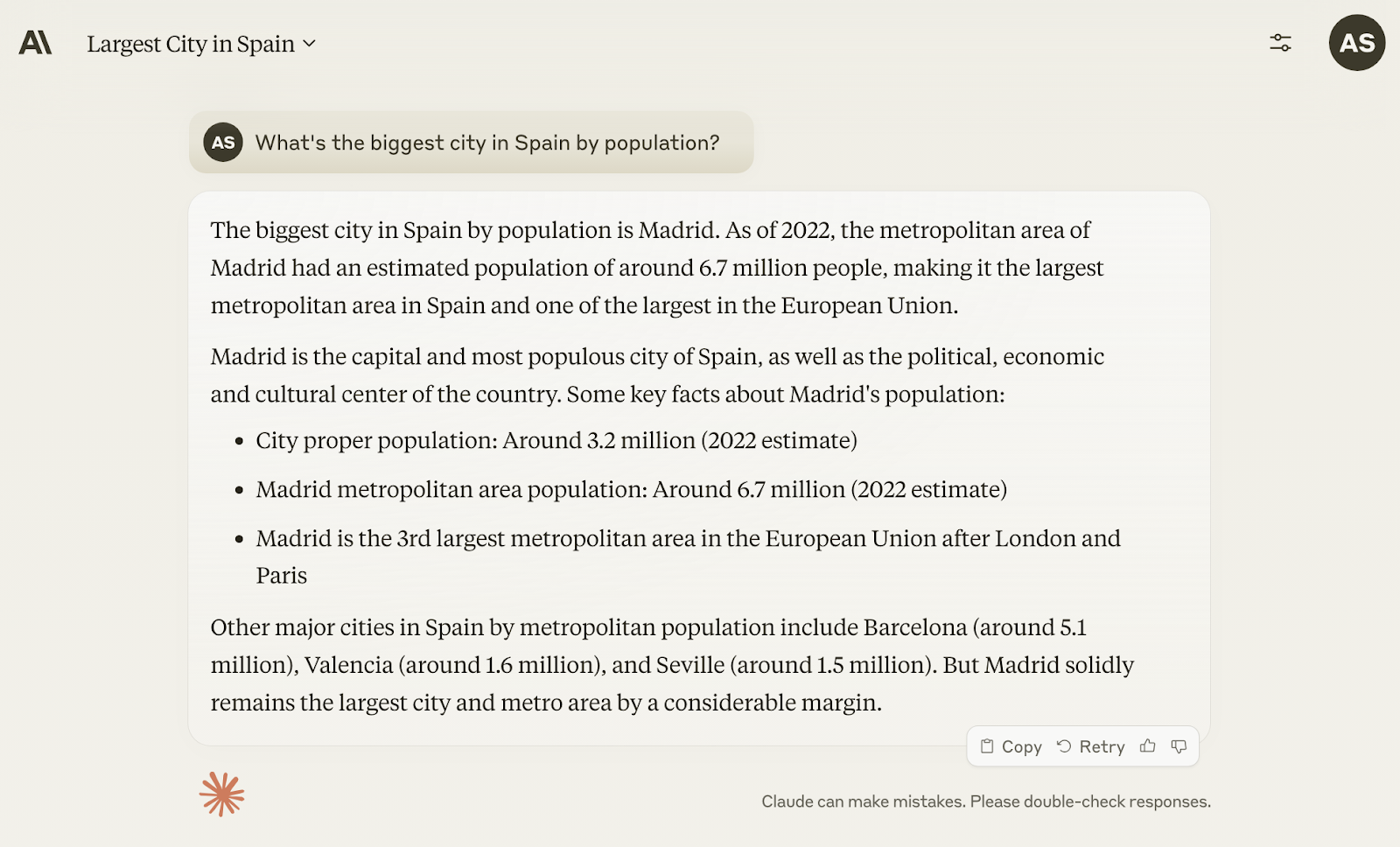
Claude can also analyze the content you upload (e.g., a spreadsheet or a PDF). It then provides summaries or answers questions based on your prompts.
Claude can assist with tasks like AI copywriting and content generation, too. In your prompt, you can include guidelines for the format and style of content you want to create.
Gemini
Similar to ChatGPT and Claude, Gemini (formerly Google Bard) is another AI chatbot that provides text responses to prompts.
Like this:
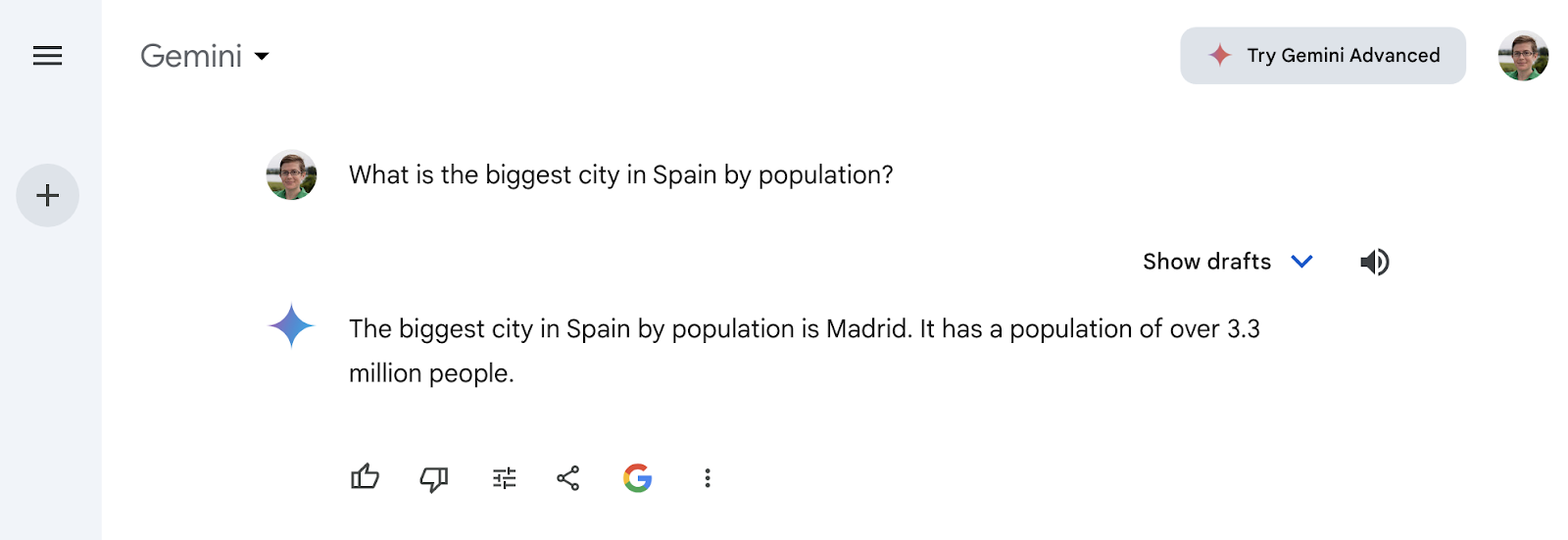
As a Google app, Gemini is integrated with many Google products. Which lets you verify its responses via Google Search with one click.
You can also prompt Gemini to summarize files in Google Drive. Like a virtual assistant.
Microsoft Copilot
Another AI chatbot, Microsoft Copilot generates multimedia responses to prompts.
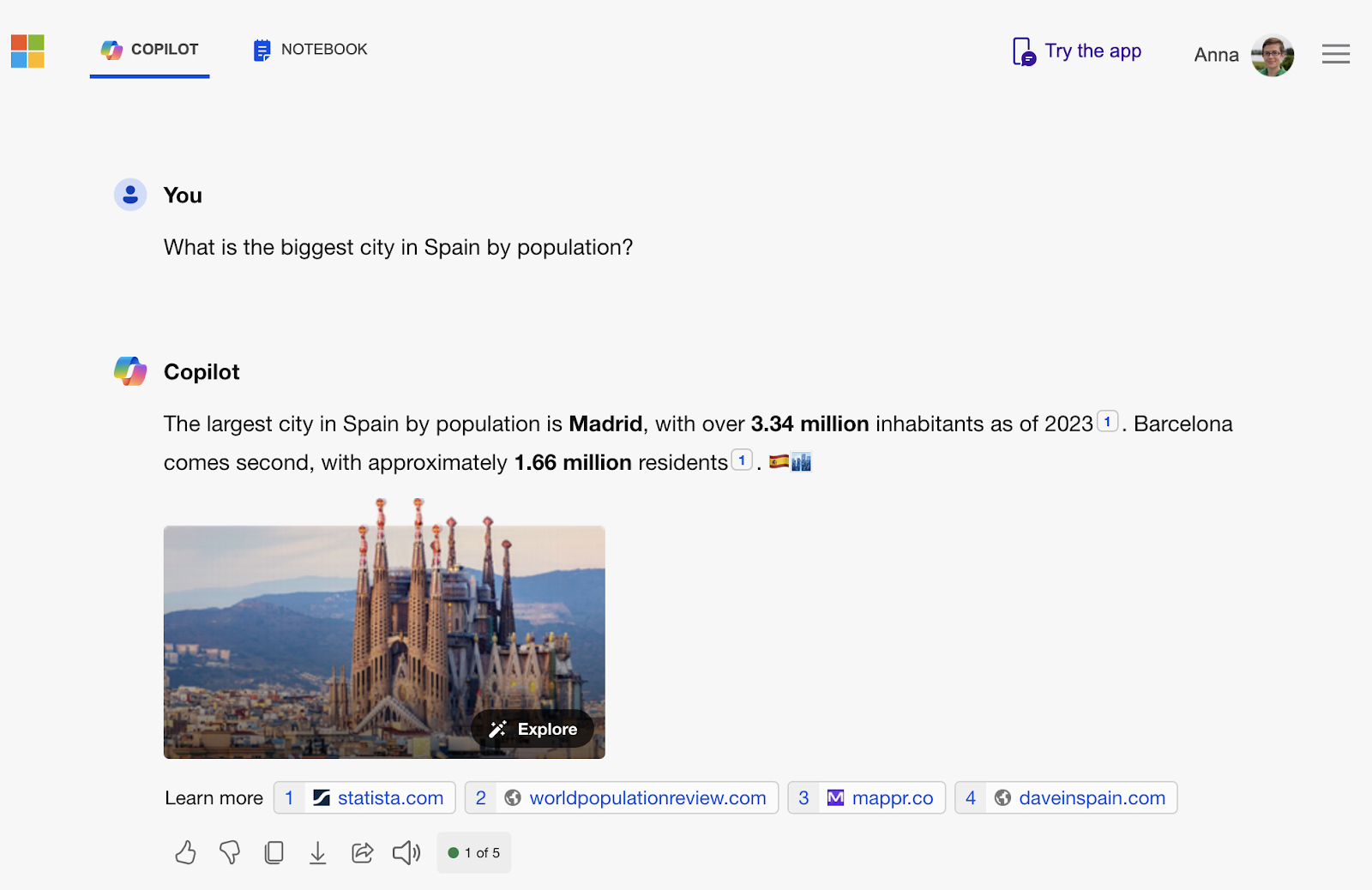
Along with producing a text answer, it shows you relevant images and links from Bing’s search results.
DALL-E
DALL-E is a text-to-image generative AI tool developed by OpenAI. It generates images based on prompts like this one:
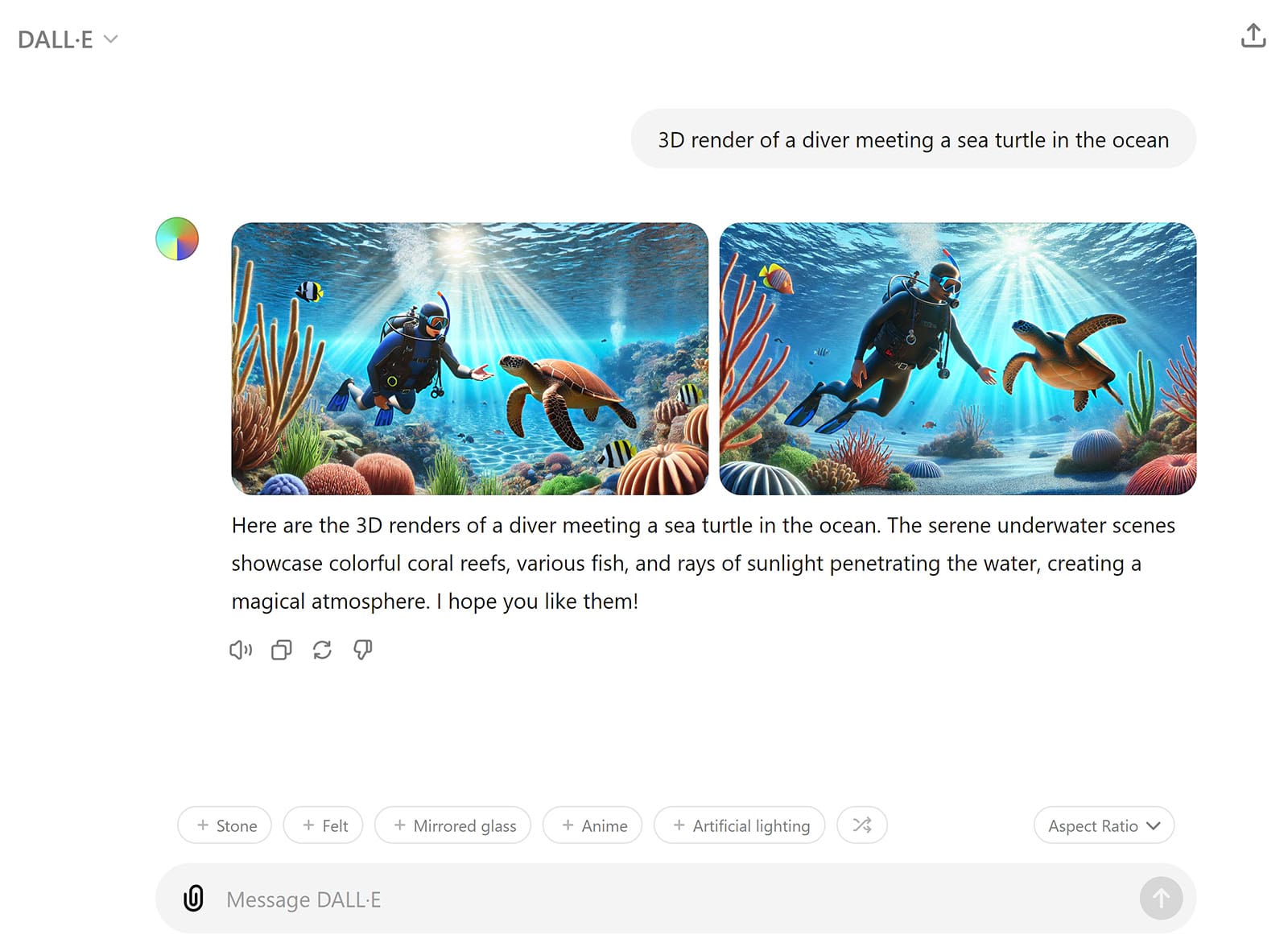
In addition to describing the contents of the image, prompts can also request a style. The more specific and detailed your prompt, the more likely the image will meet your needs.
DALL-E uses a diffusion model to analyze images and look for patterns in the components. Then, the image generation app uses what it’s learned to piece together its own AI image.
Midjourney
Midjourney is a text-to-image generator that uses diffusion models and LLMs to create realistic content.
Like this:
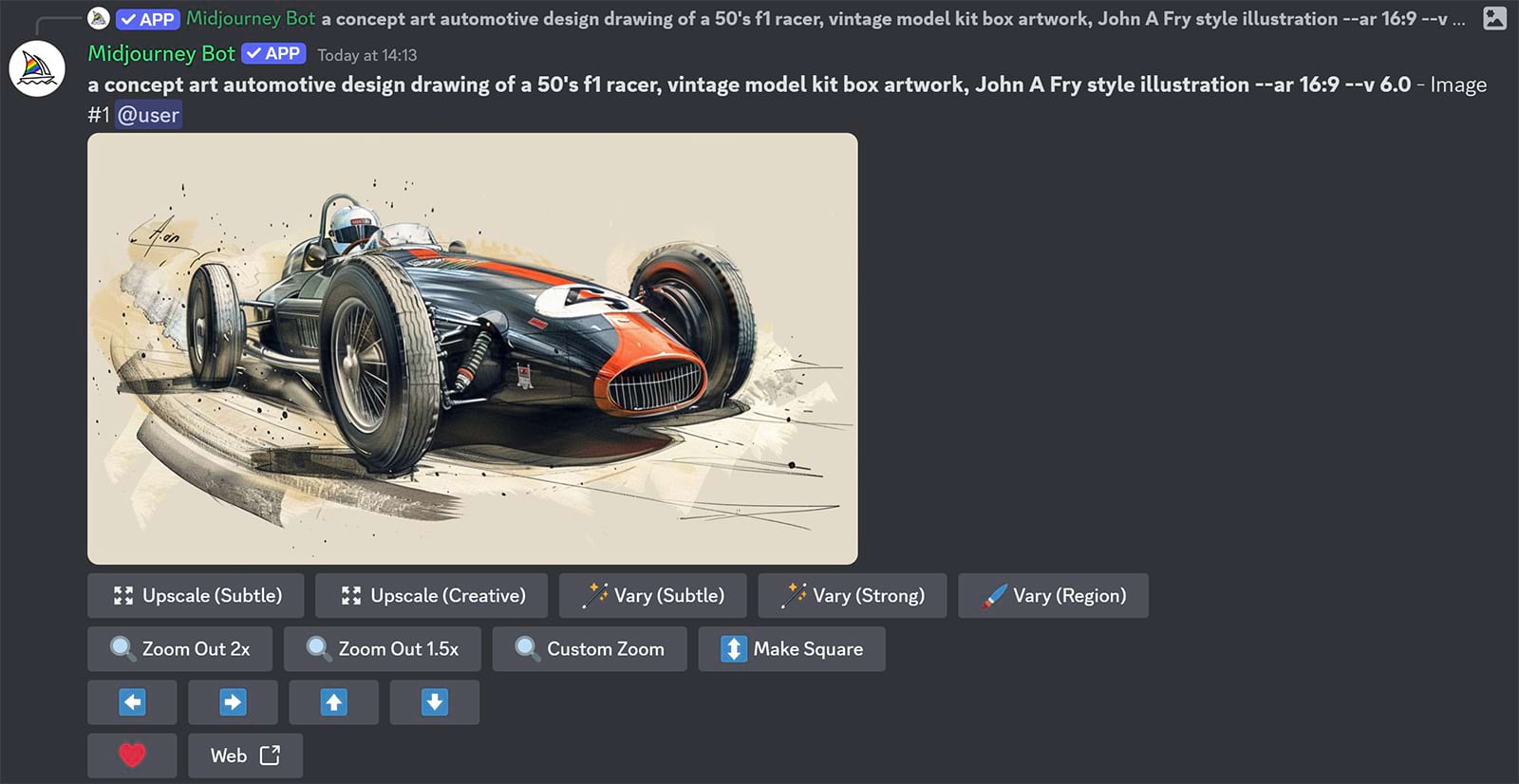
Compared to DALL-E, Midjourney’s prompts are much more complex. For example, prompts must include style and dimension guidelines.
Unlike many other generative AI tools, Midjourney isn’t a standalone app but a Discord bot. To use it, you’ll need to join the Midjourney Discord server and prompt the bot.
Further reading: 11 AI Content Generators to Make Great Content in Minutes
What Can You Use Generative AI for?
Here are the most common applications of generative artificial intelligence today.
Marketing
Generative AI tools let you quickly brainstorm marketing campaign ideas as well as draft blog posts and articles.
AI marketing software also helps with rewriting content and applying a consistent tone of voice.
Use ContentShake AI to generate written and visual content in seconds. The AI-powered tool guides you through the whole process—from ideation to publication.
From the main dashboard, click “My own idea” and enter your topic. Hit “Start writing.”
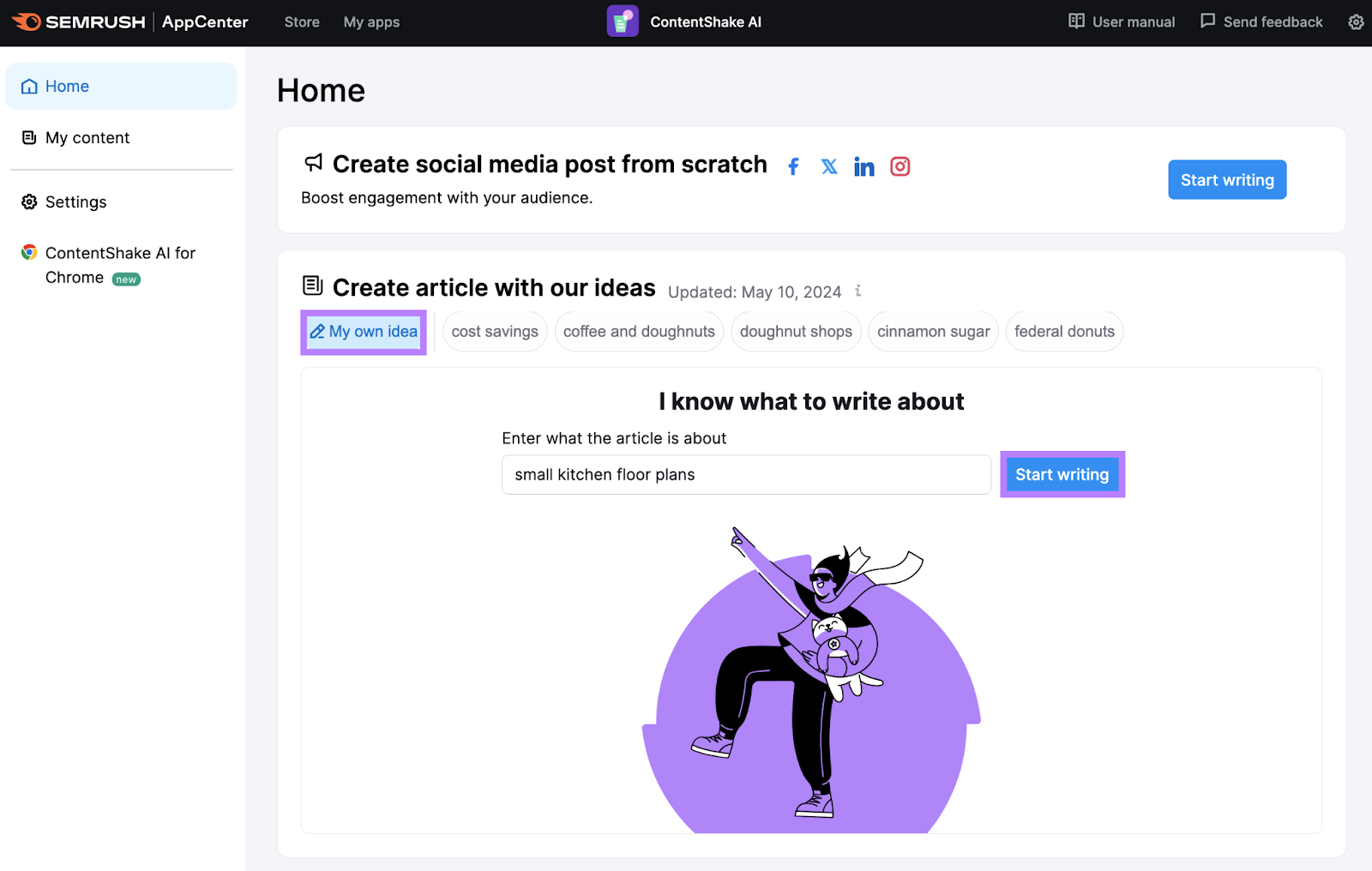
Review the suggested title, target keywords, word count, tone of voice, and readability level. Click “Create article.”
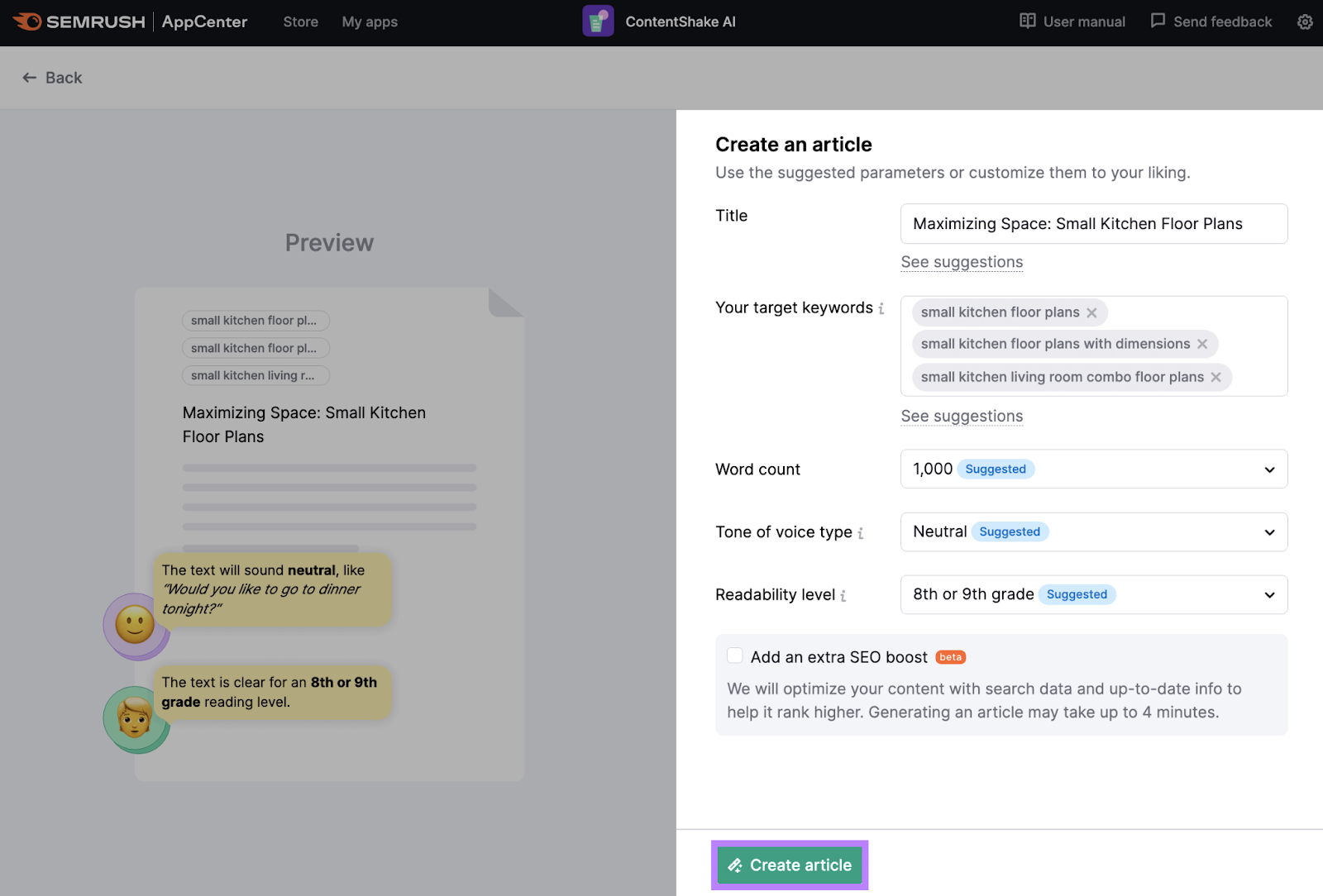
Read through the AI-generated article. Hit “Publish” to proceed as is or “Go to regenerate” to start again. To edit and optimize the content manually, click “Go to editor.”
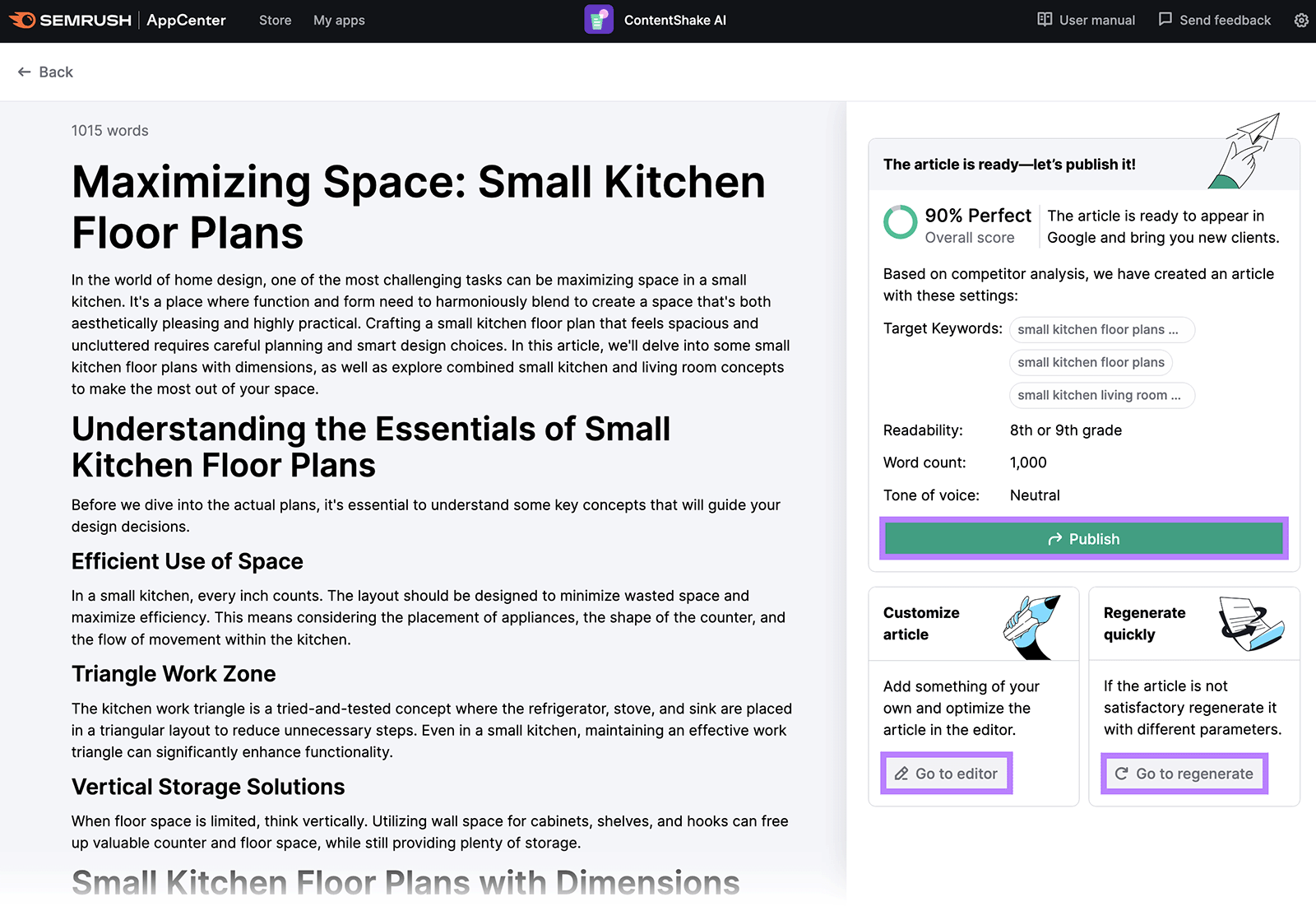
Use ContentShake AI’s preset prompts to speed up the optimization process. You can even enter your custom prompts in the chat window.
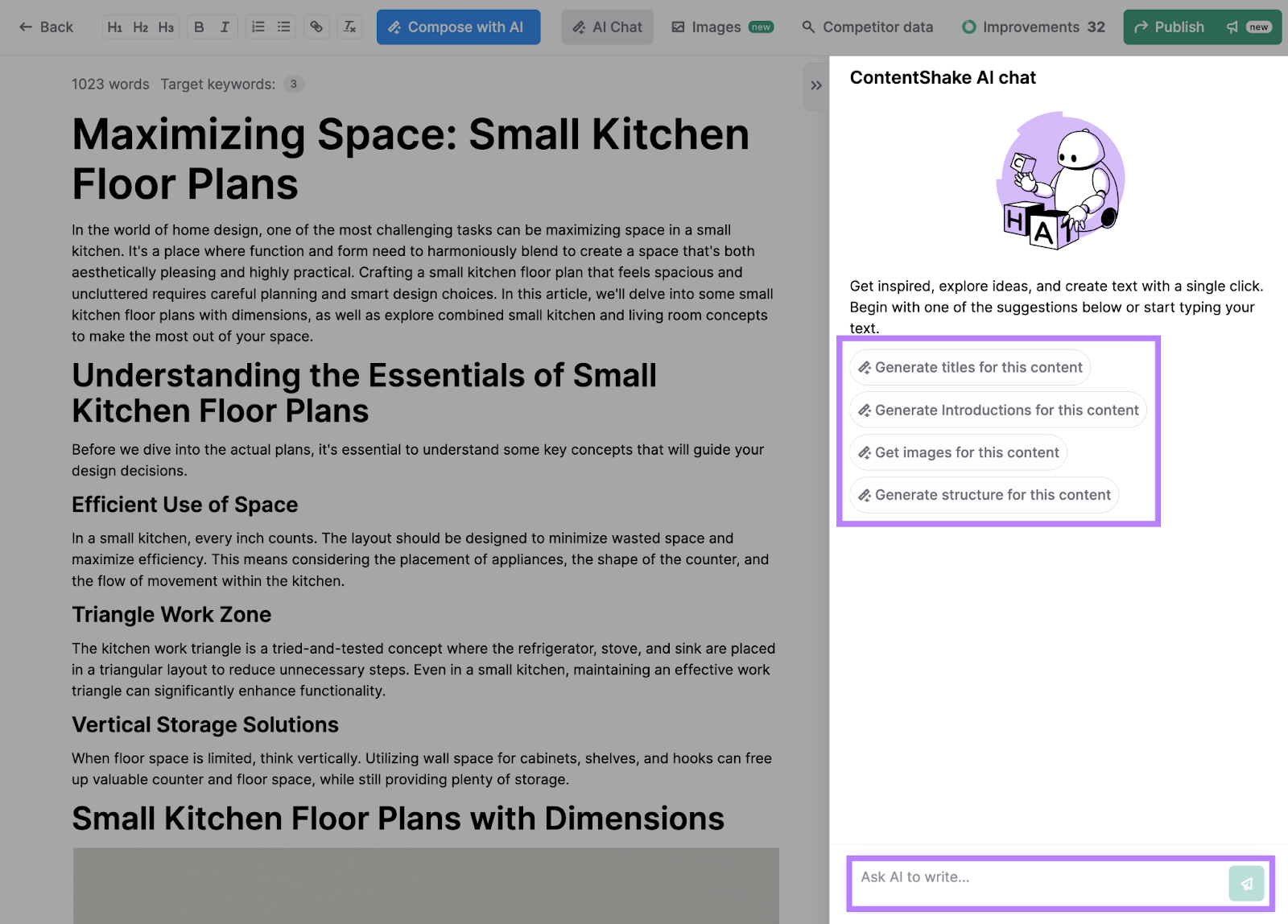
Another Semrush tool, SEO Writing Assistant, includes AI features to help you write online marketing content faster. It also checks the SEO potential of your work.
Click the “+ Analyze new text” button on the tool dashboard.
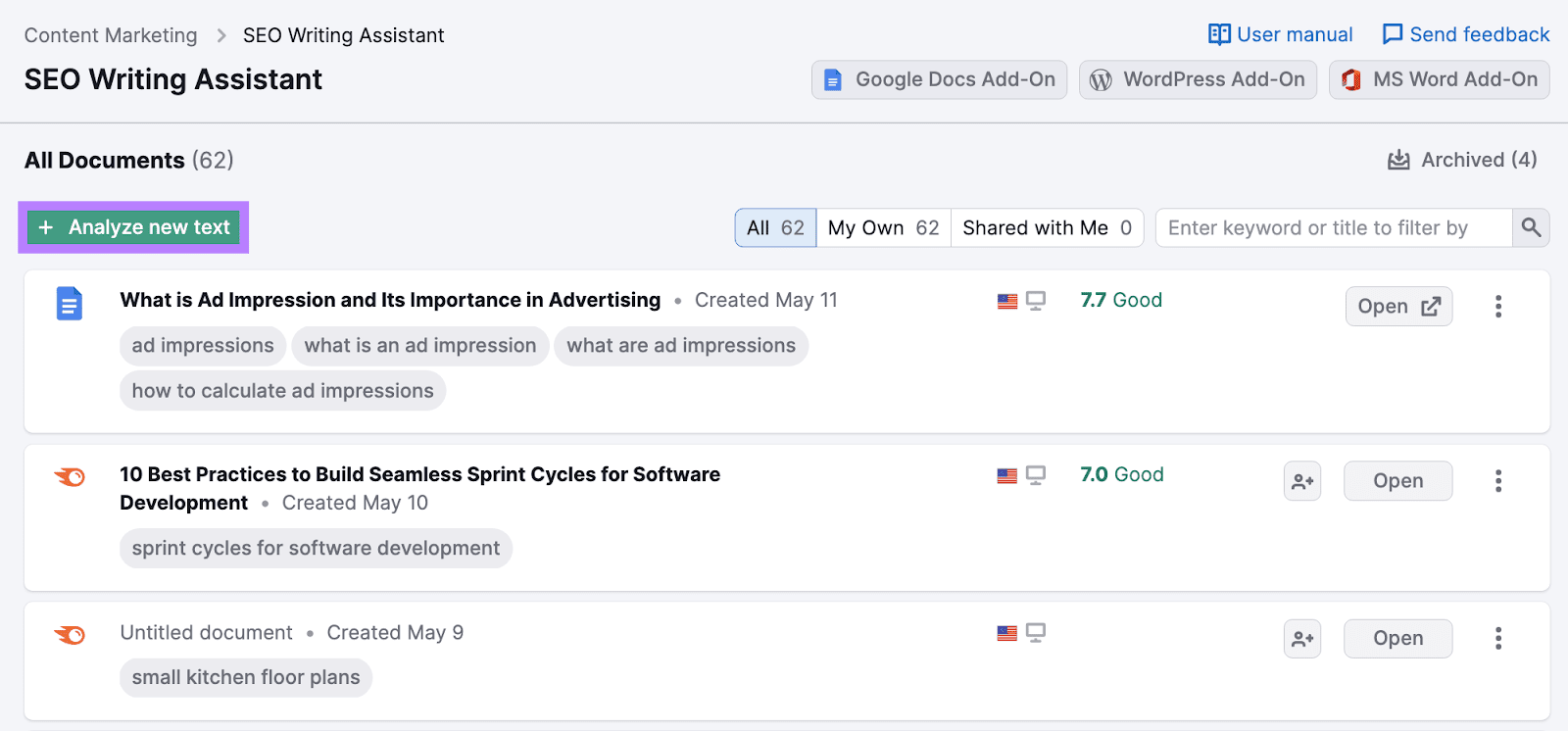
If you’ve used the tool before, click the “Set a new goal” drop-down.
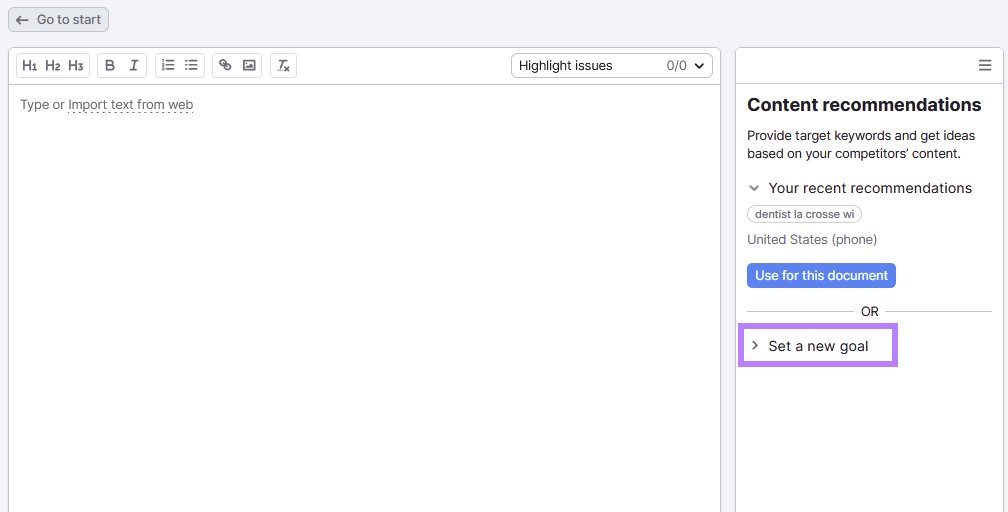
If you’re using this tool for the first time, input the keyword you intend to target and click “Get recommendations.”
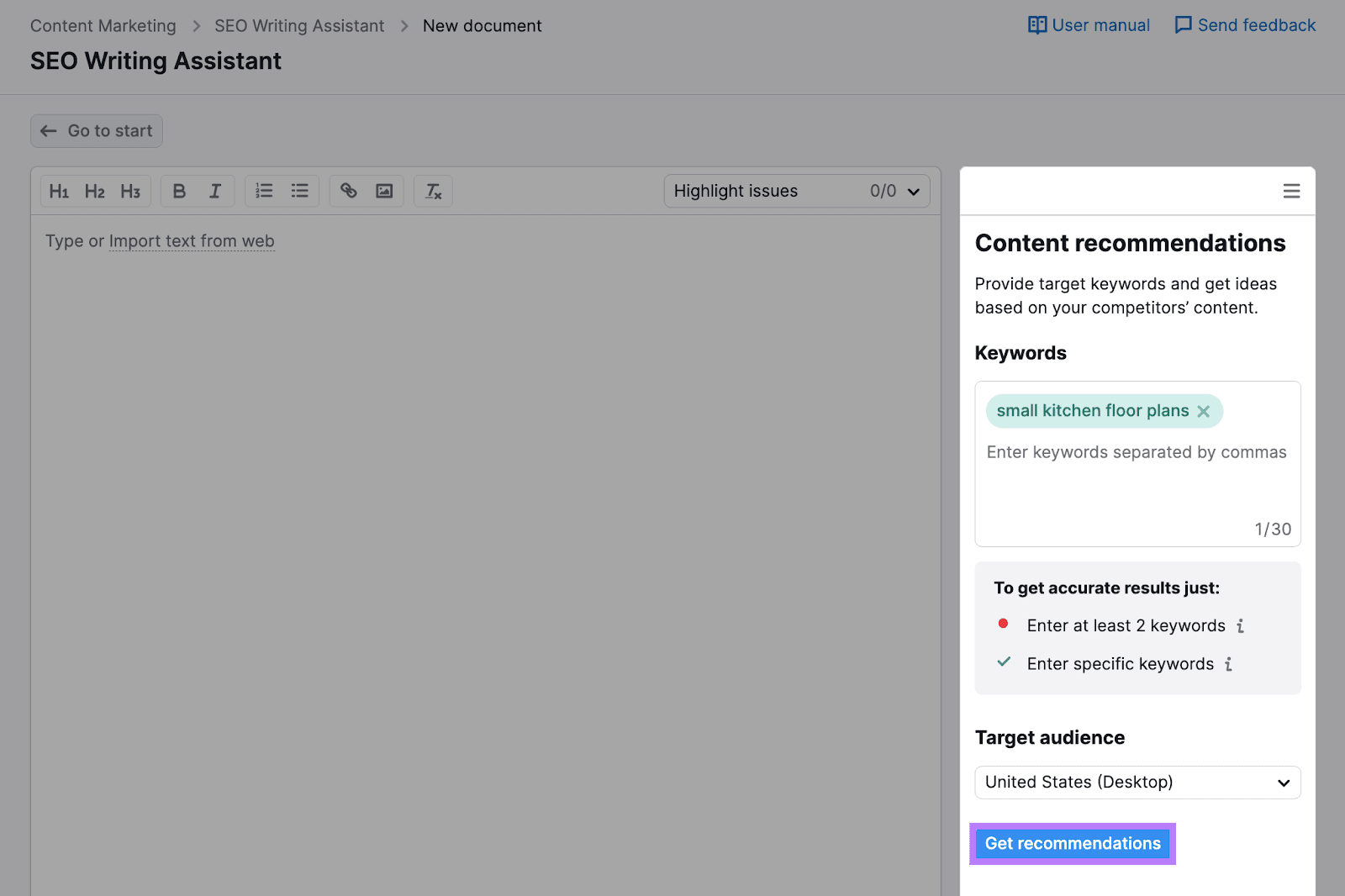
Draft or outline your content. Then, use SEO Writing Assistant’s AI features to improve your writing.
Select any phrase, sentence, or paragraph and click “Expand” to elaborate on those sections.
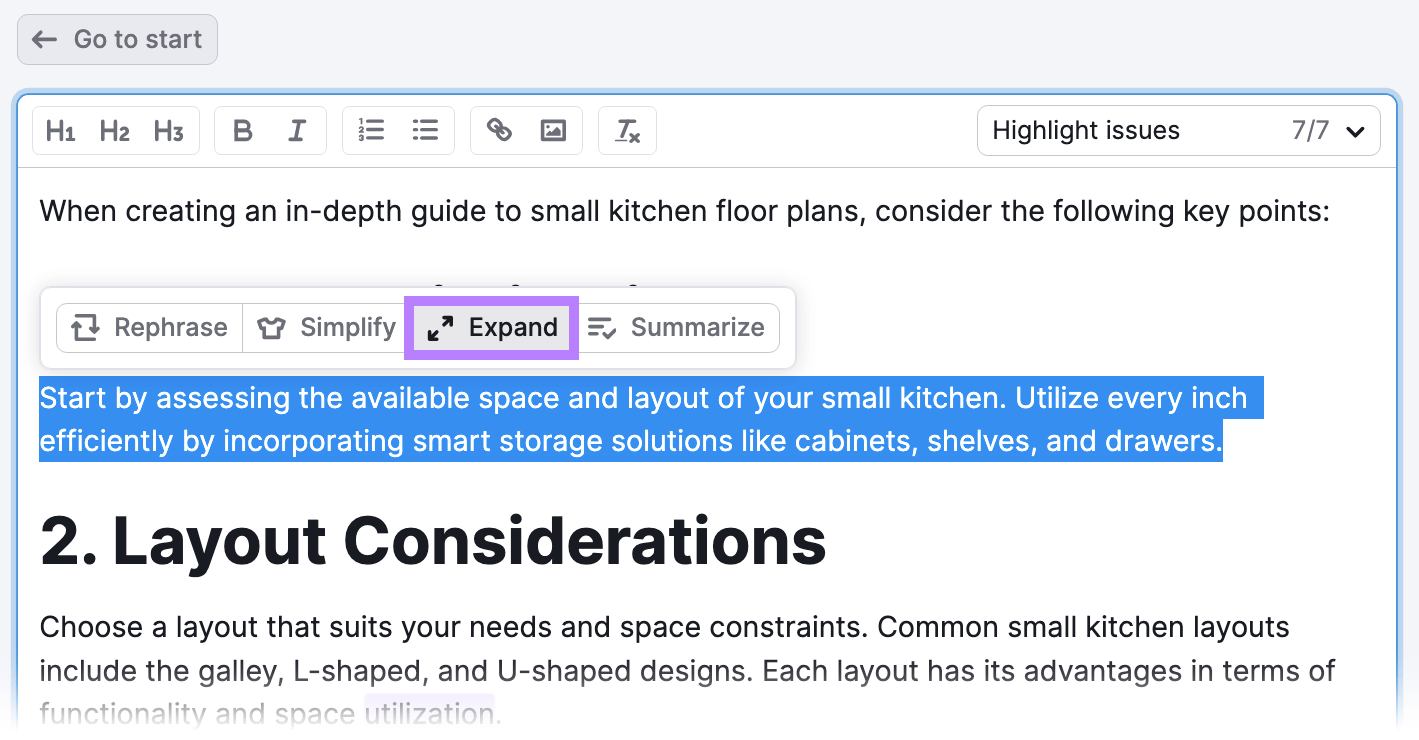
Review the content for accuracy and style. Then, click “Accept,” “Reject,” or “Try again.”
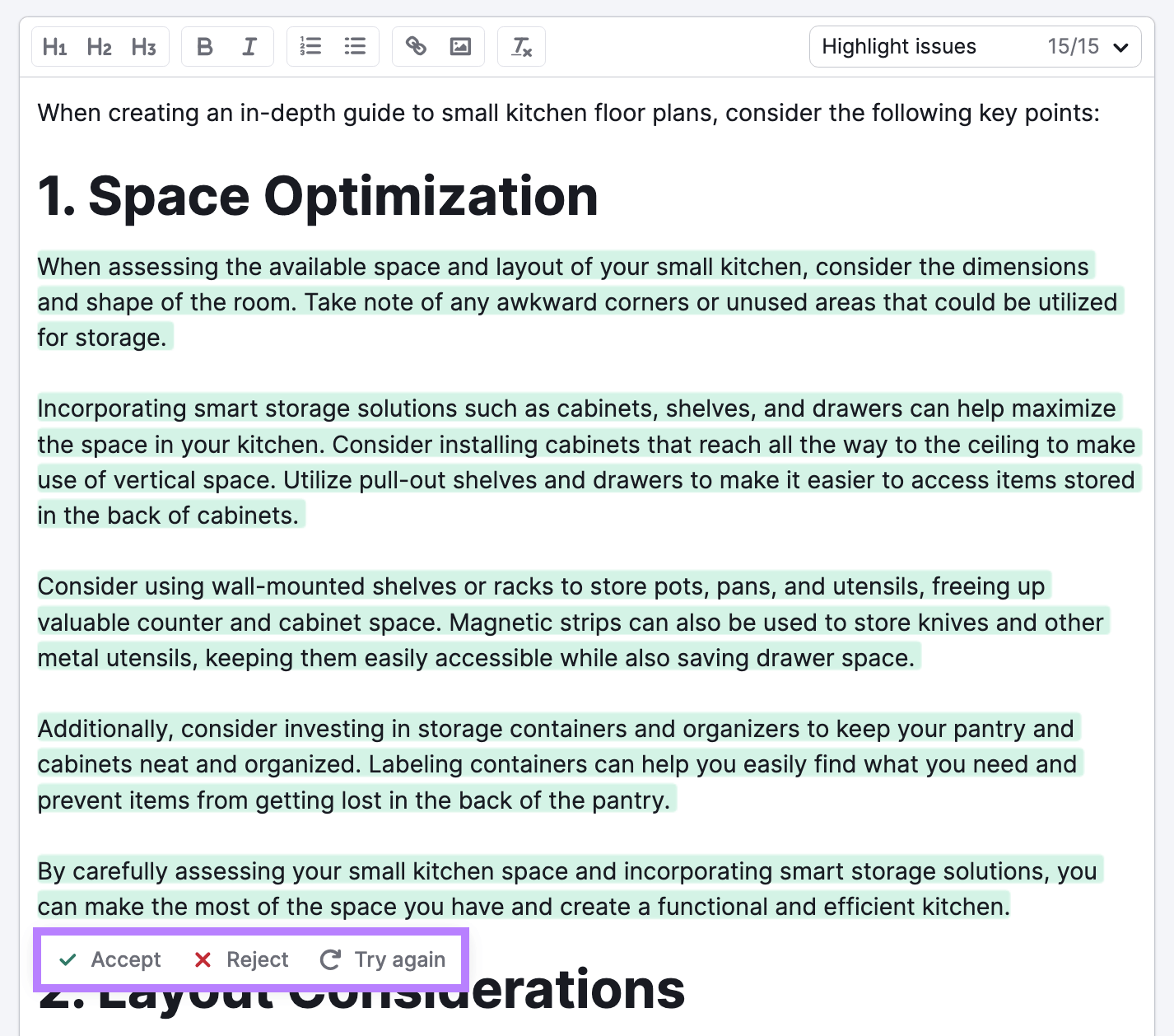
Alternatively, open the “Smart Writer” drop-down and select “Rephraser.” Input your text and choose one of the four optimization options. Then, click “Rephrase.”
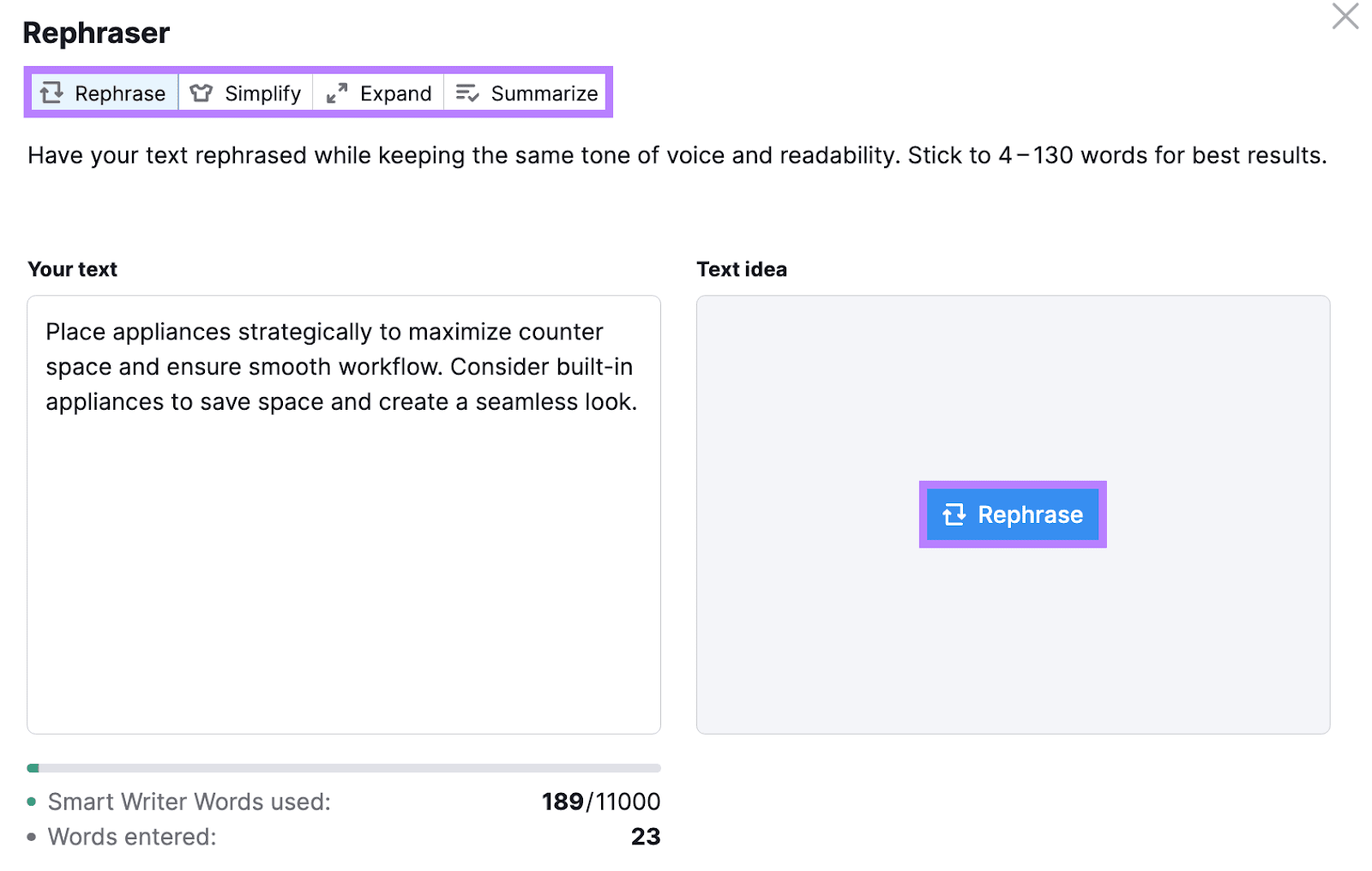
Review the AI-generated ideas and click “Rephrase” to generate more. Use the copy button to choose where to paste the text, or click “Replace and close” to insert it where the cursor is positioned.
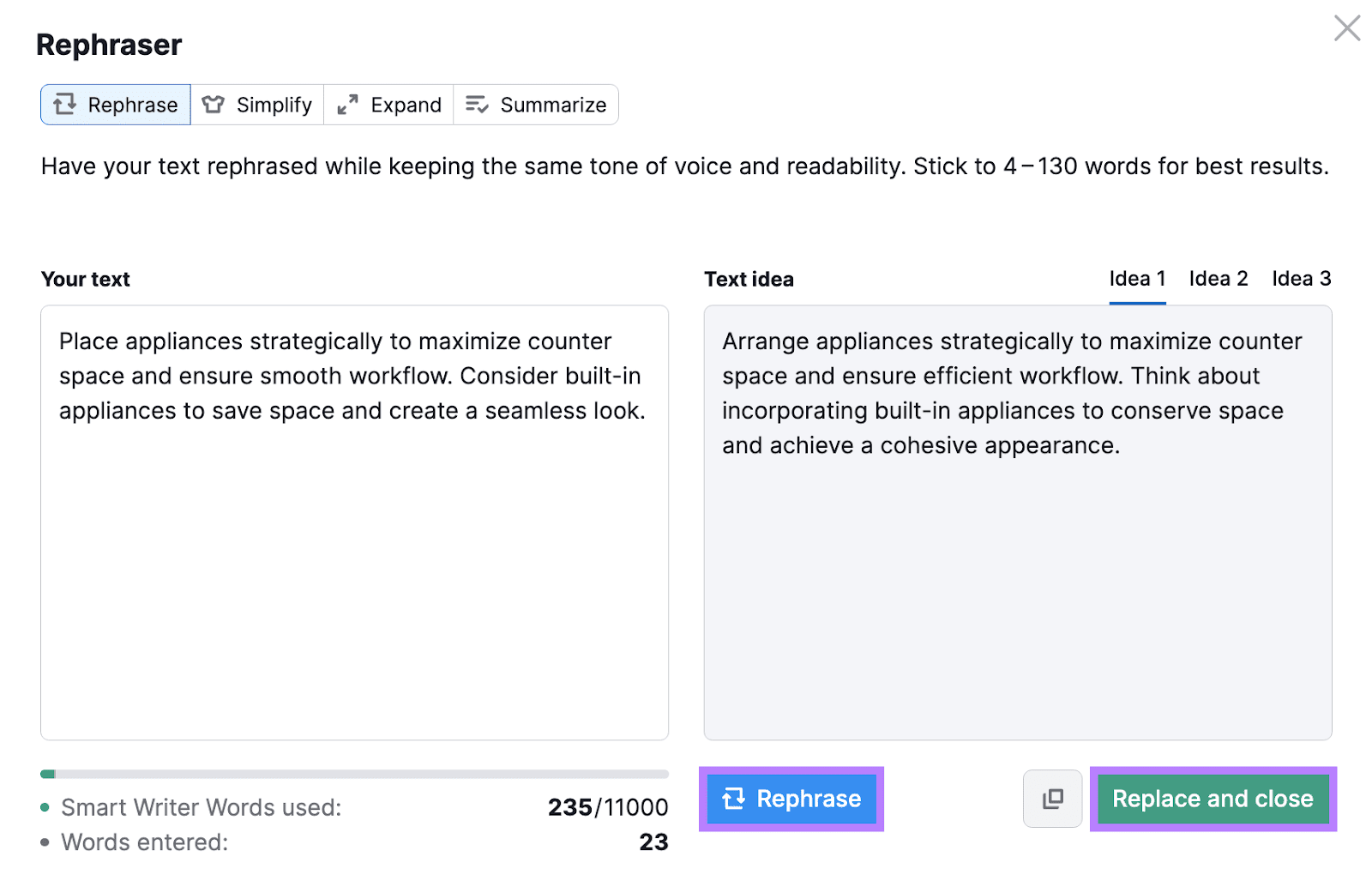
Use the AI-powered Smart Writer from Semrush to elaborate on existing content.
Write at least a few sentences. Then, click “Compose” to generate more copy.
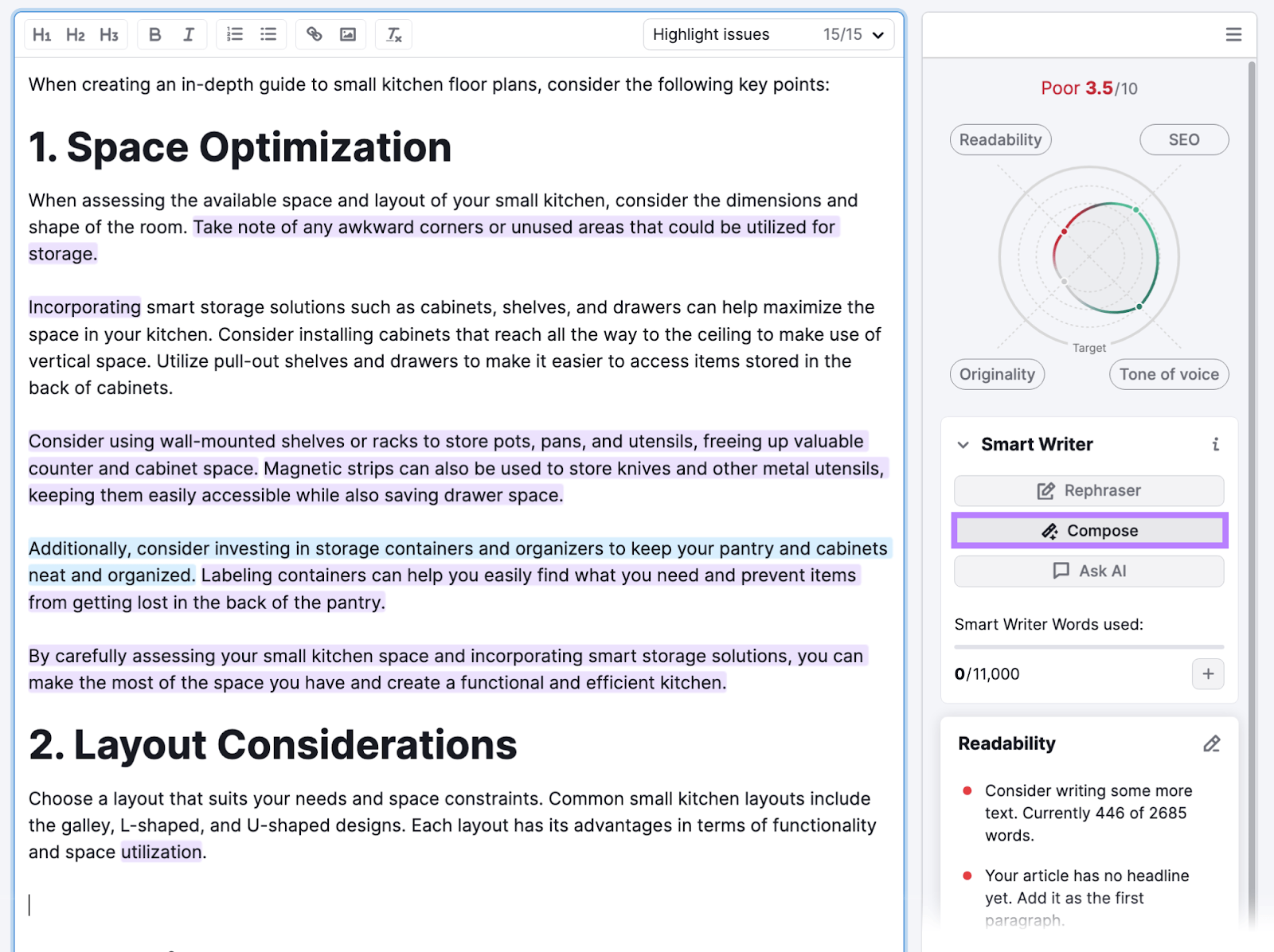
Select the “Ask AI” feature to submit custom questions or prompts. Then, click “Ask.”
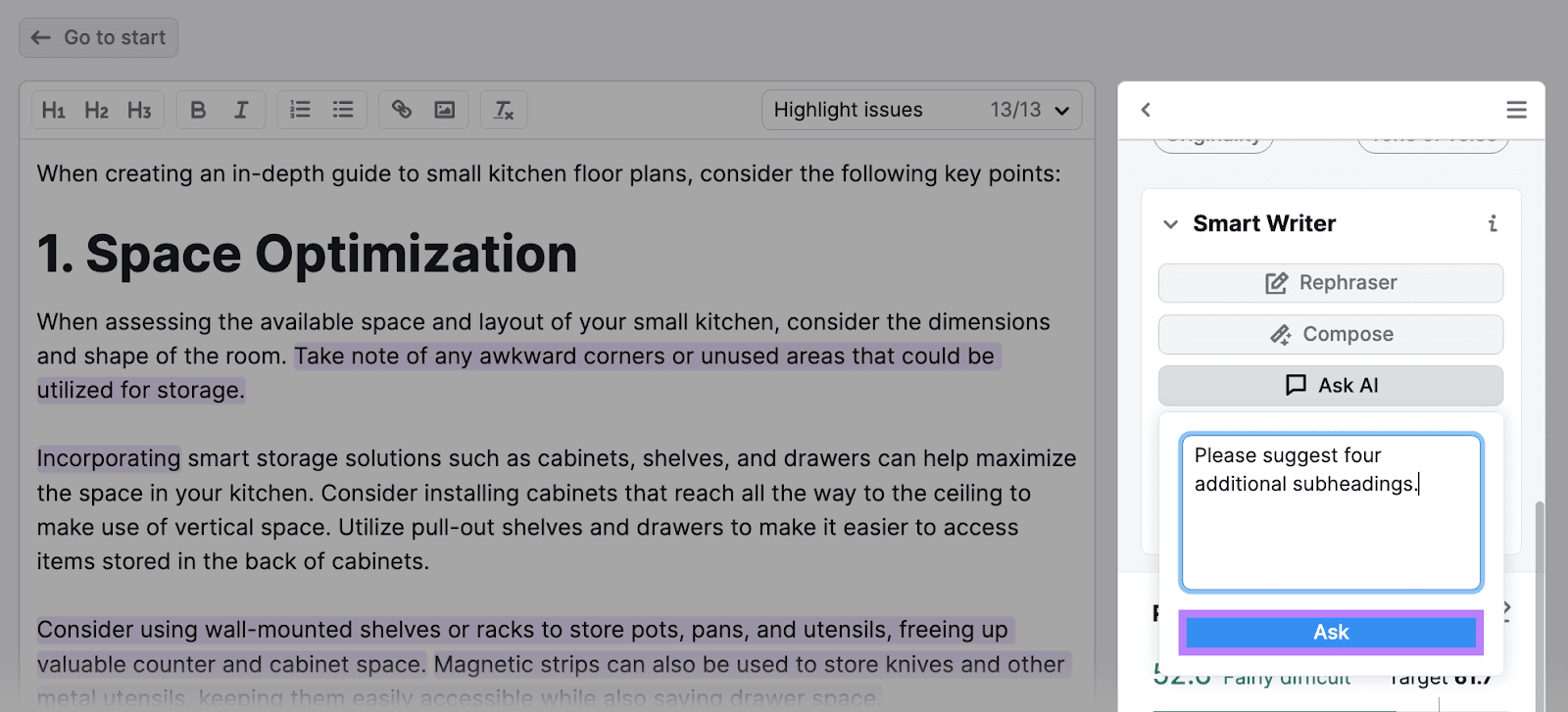
As you create your content, keep an eye on the score in the upper right corner. Aim for as close to 10 as possible. This score factors in readability, tone of voice, originality, and SEO.
Advertising
You can take advantage of AI advertising tools to generate both copy and creatives for your paid promotions.
AI Writing Assistant allows you to compose ad headlines quickly.
Open the app from the Semrush App Center and select “All Tools” > “Social Media & Ads.”
Then, choose either “Facebook Headlines” or “Google Ads Headlines” to generate ad headlines. Or “Facebook Primary Text” or “Google Ads Description” for ad description text.
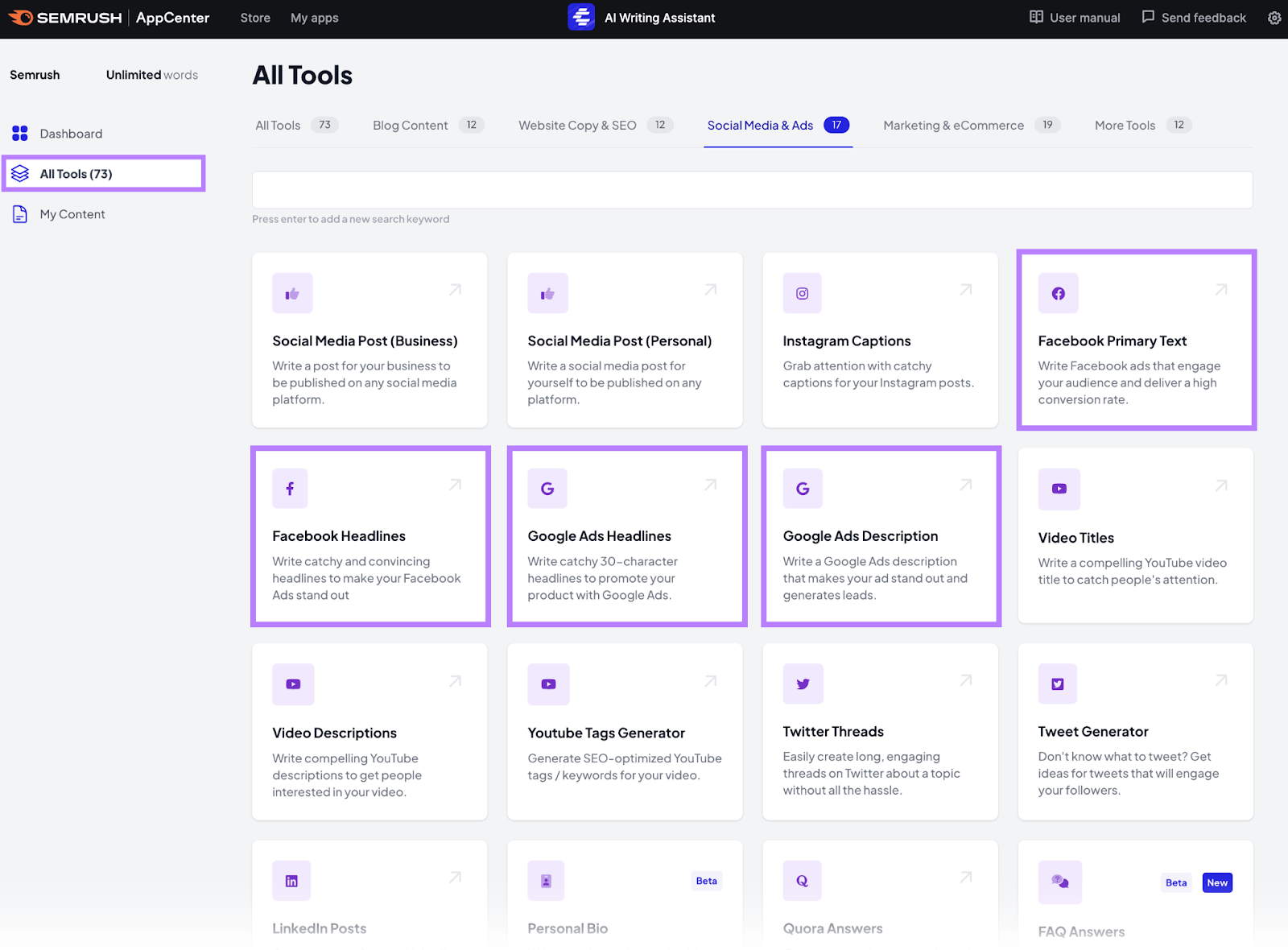
Select a language, creativity level, and tone of voice. Next, input your audience and product name details and write a short product description. Click “Generate.”
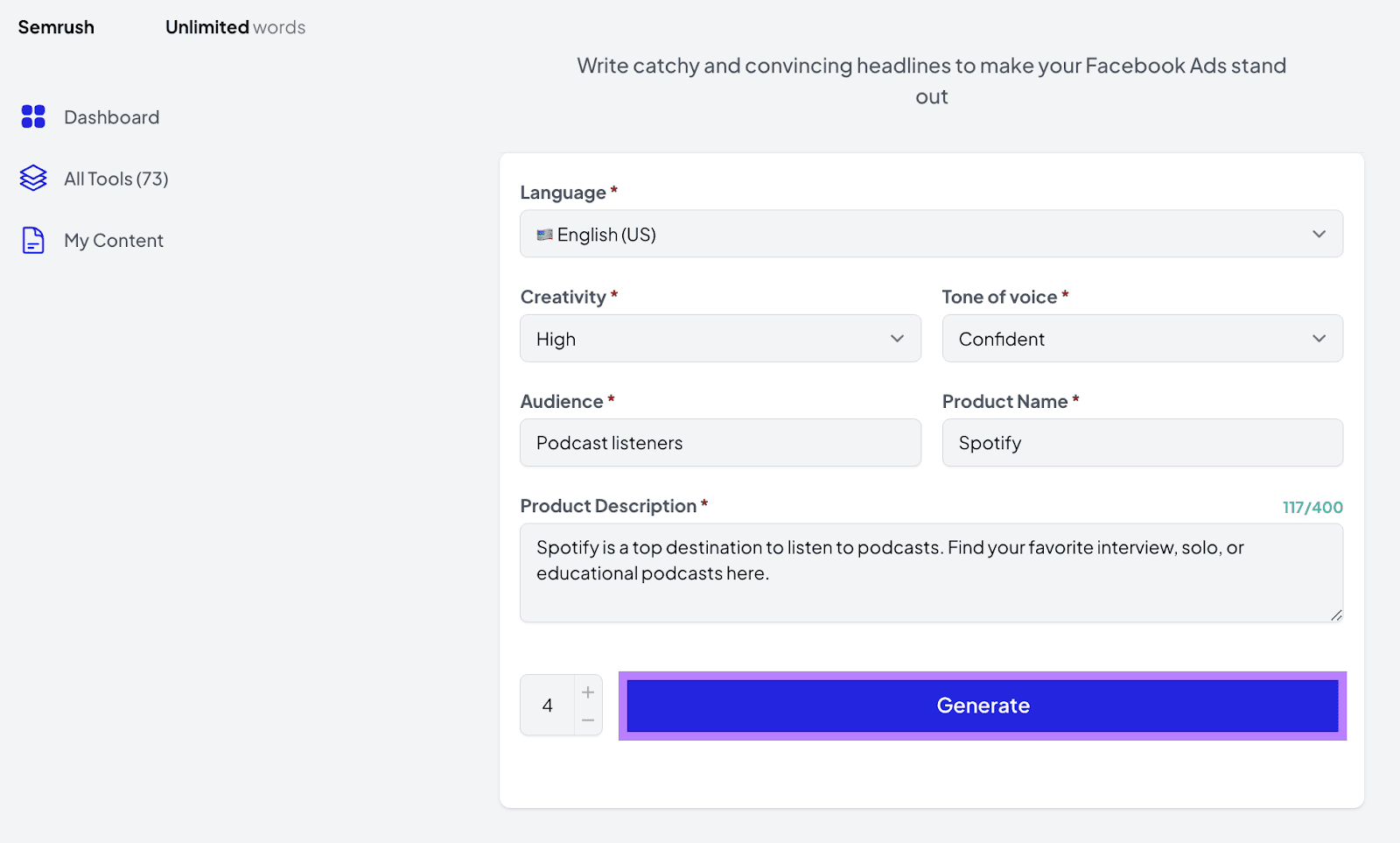
Review the results. Save any headlines you like—or copy and paste them directly into your ad platform.
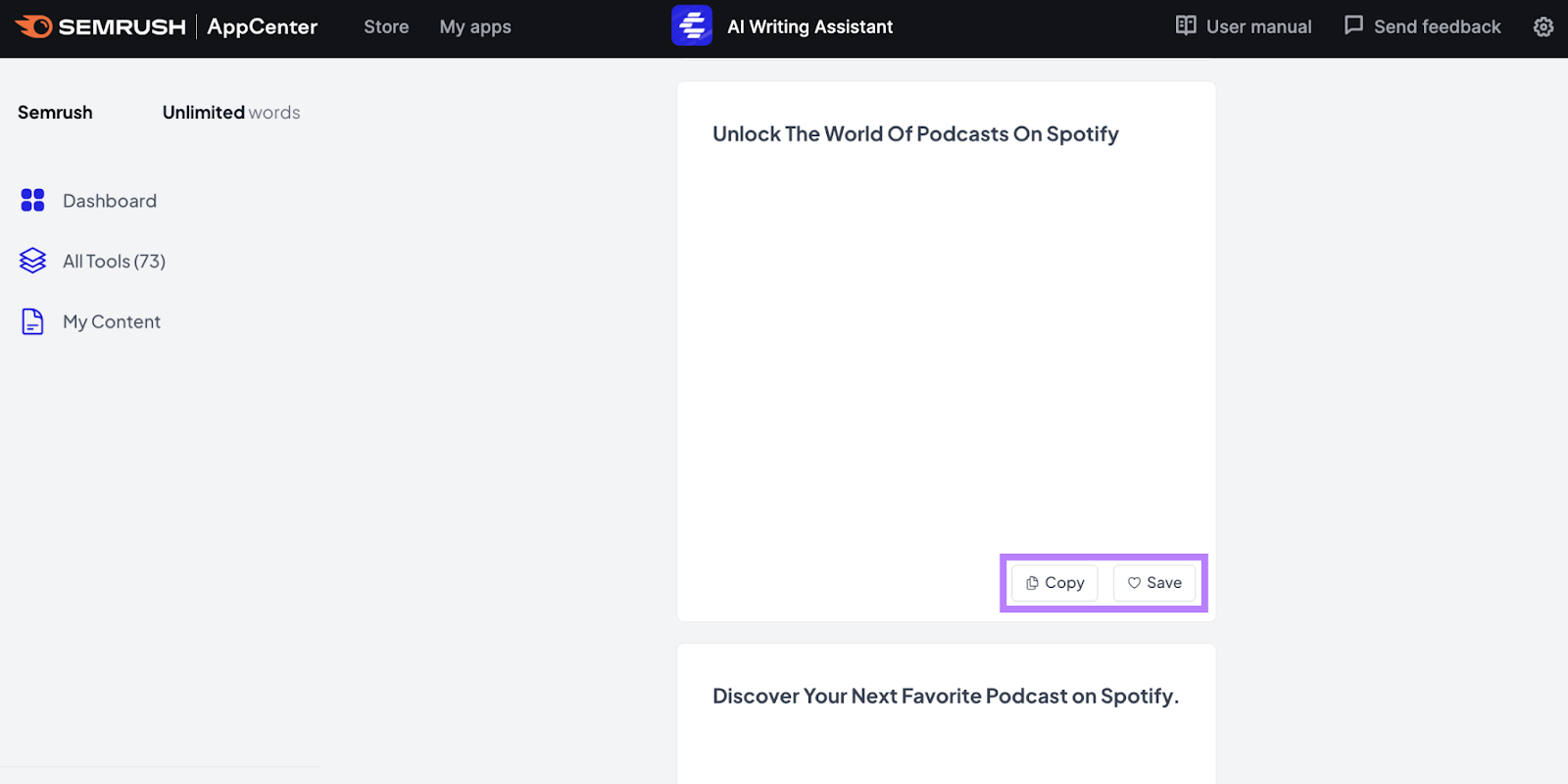
To generate complete ad creatives, open Semrush’s AdCreative.ai.
Enter your domain or landing page, and click “Import Brand” to add brand elements quickly.
The app automatically identifies your brand name, logo, and colors. Review them and click the “Create Brand” button.
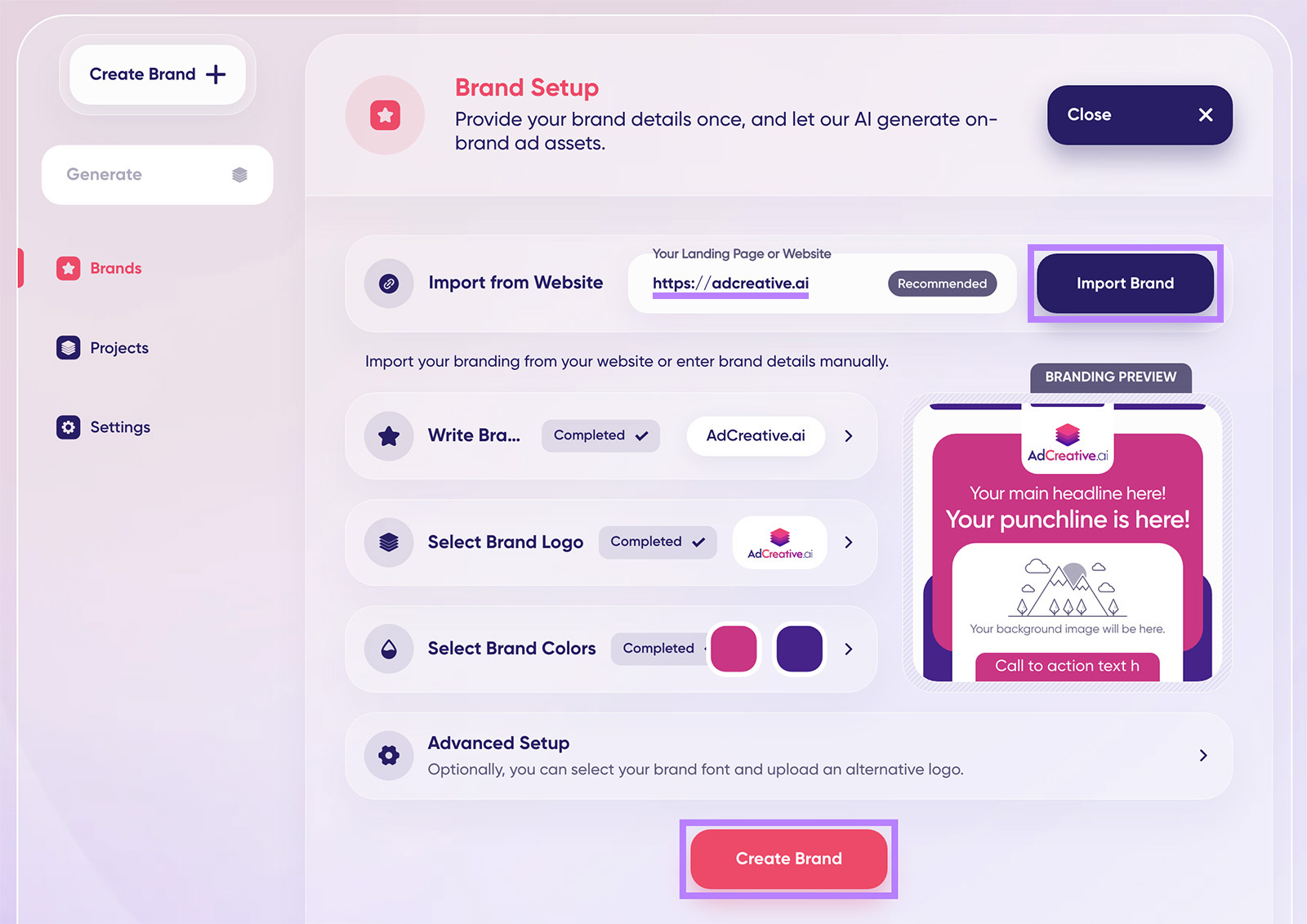
From the list of asset types, select “Ad Creatives.”
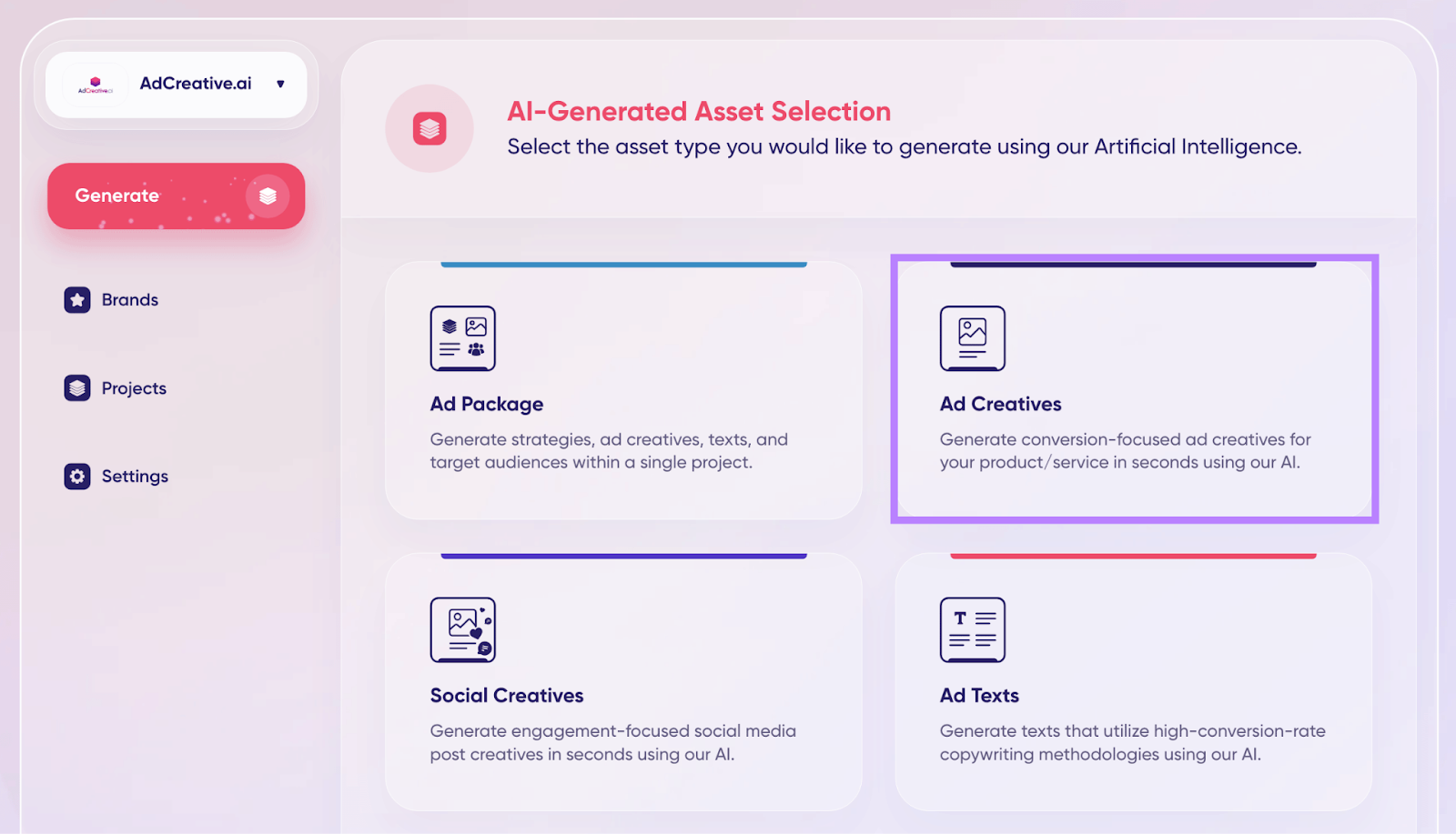
Choose the creative format that best fits the advertising platform and hit “Next Step.”
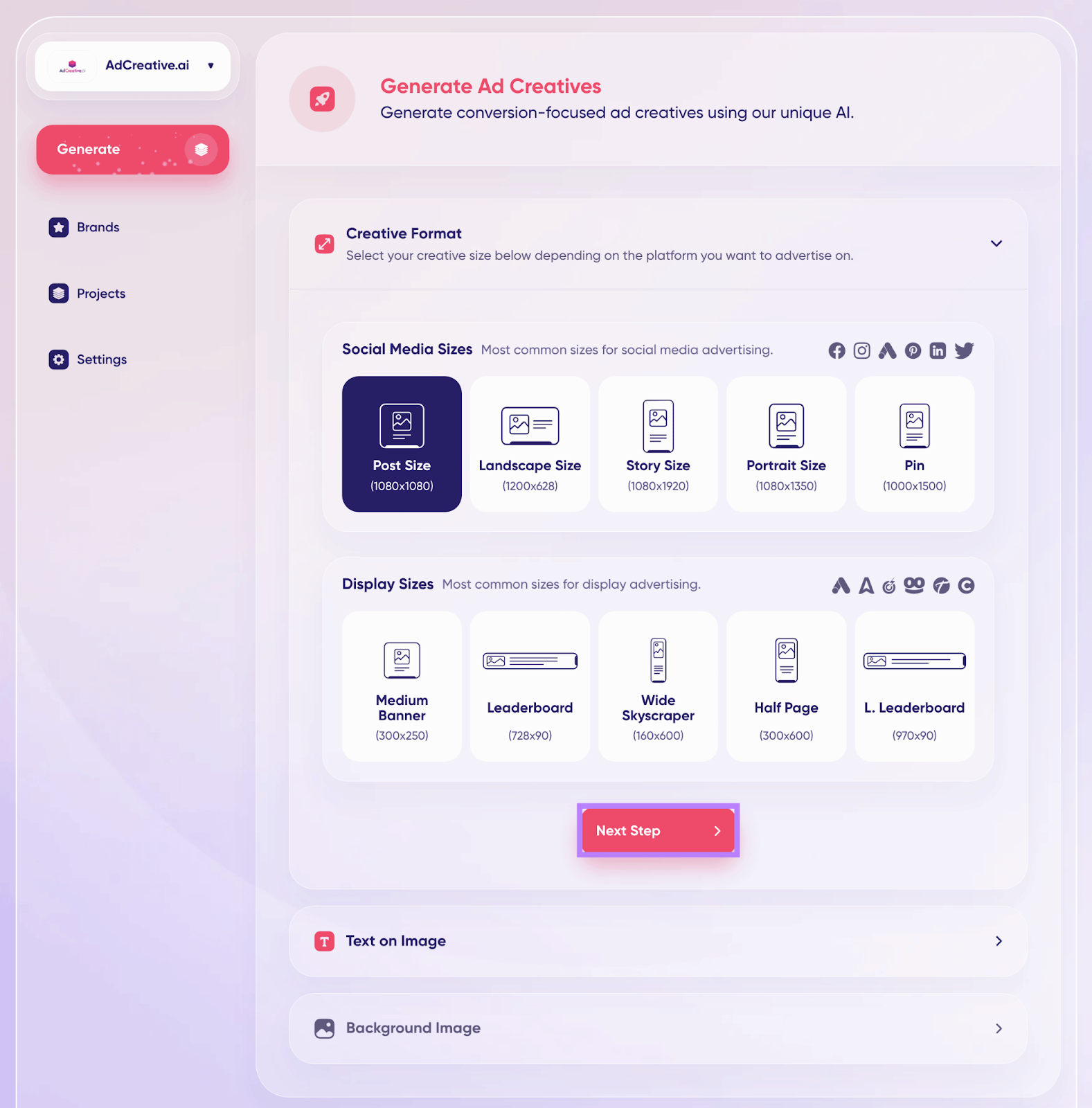
Click the “Generate Texts” button to create text with AI. Click “Next Step.”
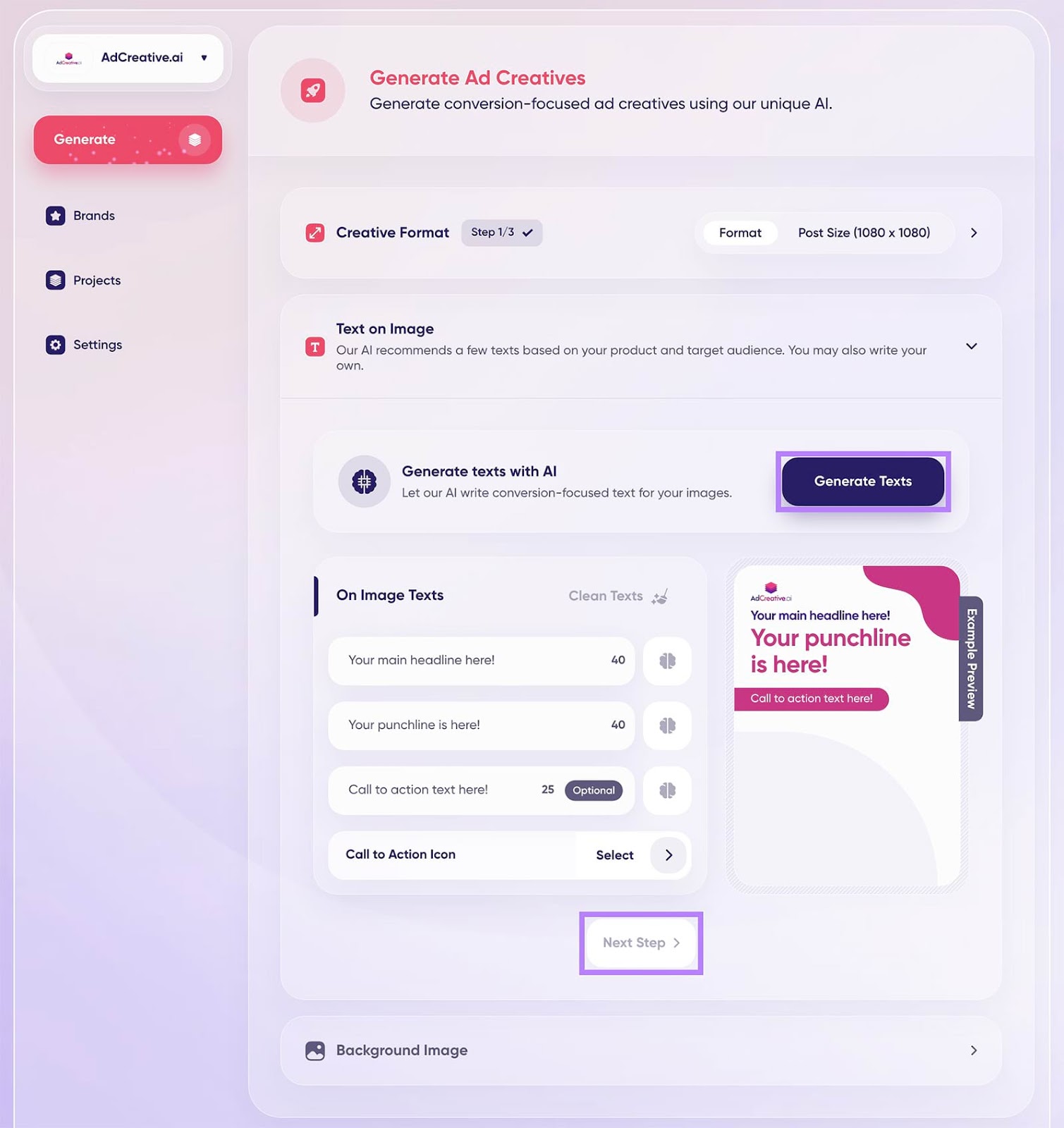
Input some information about the content you want to generate. Then, click “Save & Generate.”
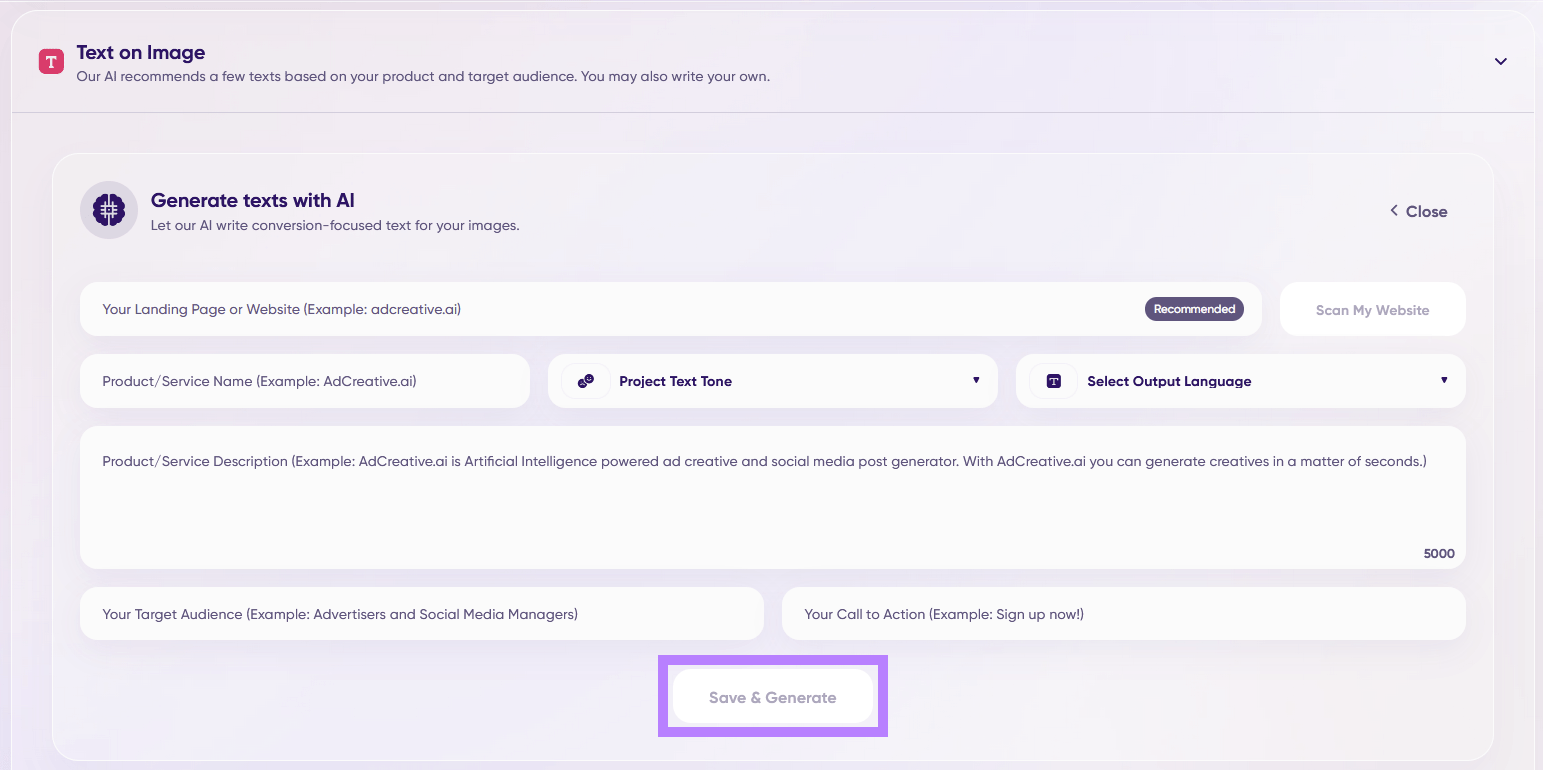
Upload a background image, crop it if necessary, and enter a project name (optional). You can also use the app’s image search engine to source background images. Finally, click “Generate.”
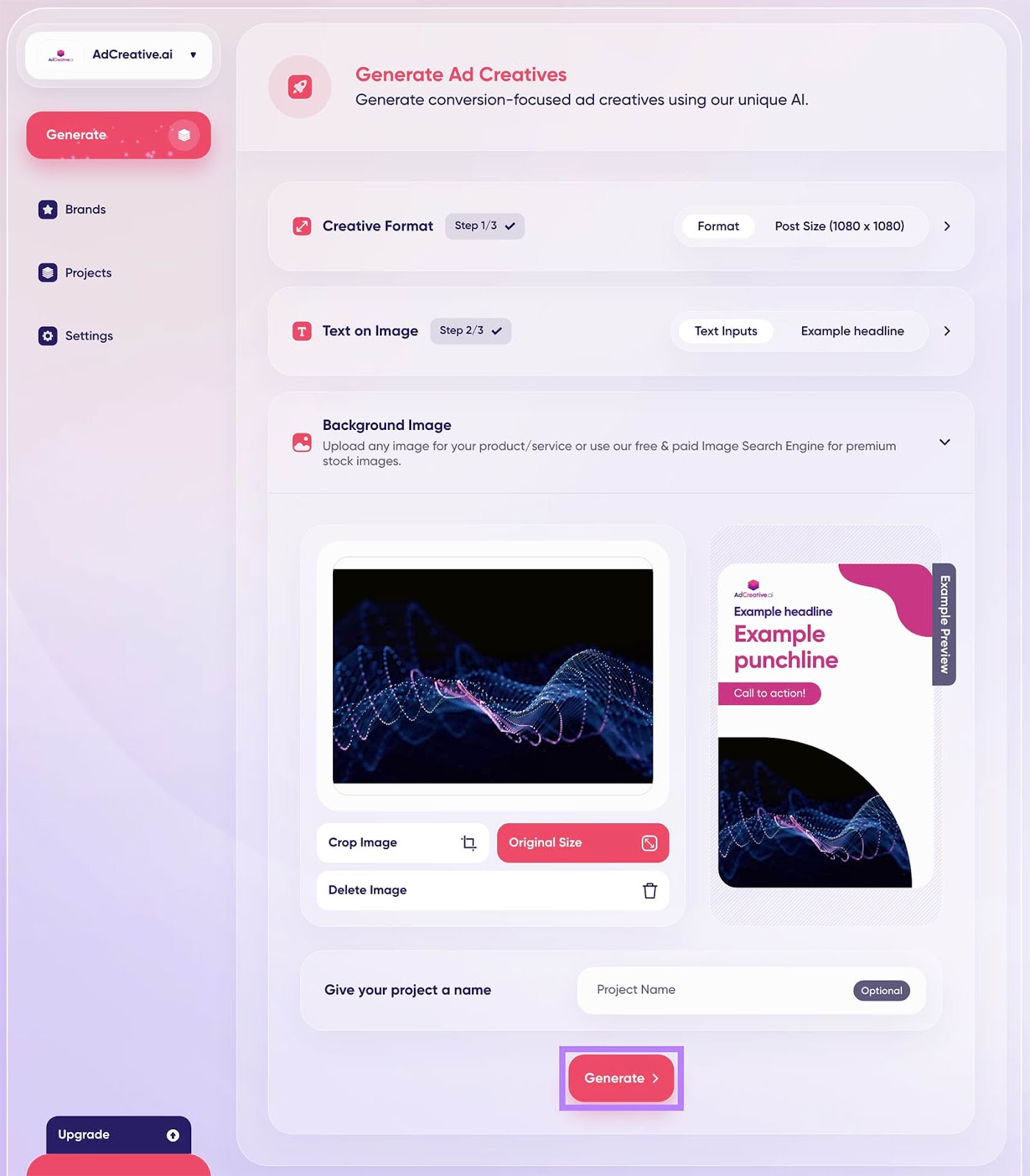
Check the box below for all the AI-generated assets you want to use and hit the “Download” button.
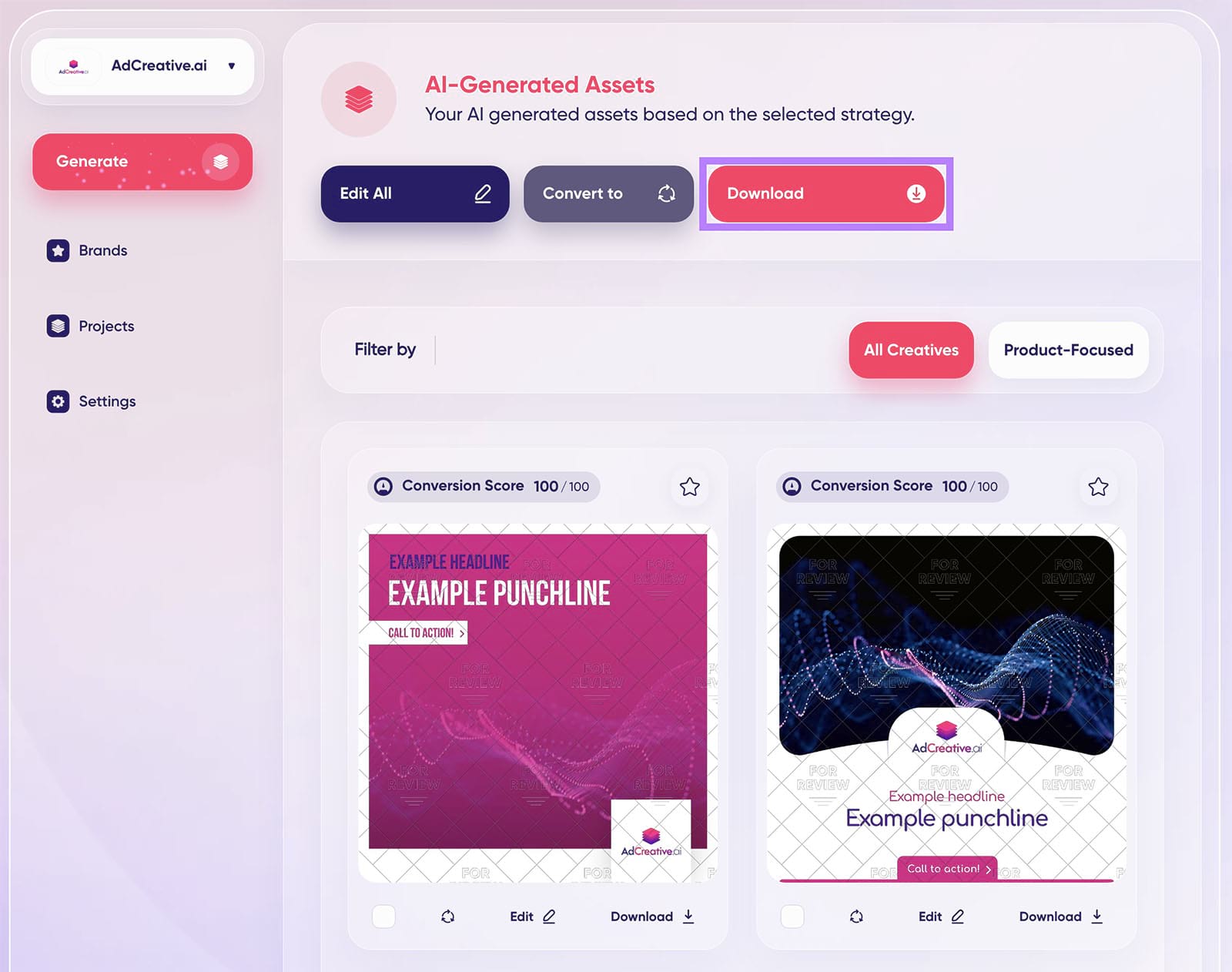
You can now upload the digital assets to your ad platform and set up your ad campaign.
Media
Film, animation, and gaming studios use generative AI to produce creative content more efficiently.
With advanced AI tools, they can generate realistic 3D models, avatars, and video content.
For example, large gaming studios can use gen AI to create more photorealistic characters or speed up game design workflows.
Coding
Software developers are able to code programs and applications with generative AI tools like GitHub Copilot.
The benefits include writing more consistent code in various programming languages, debugging code faster, and improving developer efficiency.
Healthcare
Generative AI models serve the medical industry across a wide range of applications.
For instance, medical researchers use gen AI for genome sequencing and drug research. Health practitioners use them for medical imaging and assigning accurate medical codes.
Automotive
Auto manufacturers use AI models to improve vehicle design and implement in-vehicle AI-powered virtual assistants.
Generative design inspired BMW’s “Alive Geometry” in the Vision Next 100 concept car, which enables shape-shifting parts that interact with the driver.

Image Source: BMW
Many manufacturers also provide basic customer service using AI before involving human agents.
A 2023 Deloitte report anticipates that generative AI will lead to a 20% equipment availability increase and a 10% annual maintenance cost decrease for the automotive industry.
Data Synthesis
It’s impossible for generative AI models to learn or improve their processes and computations without training data. However, training data doesn’t necessarily exist for every possible industry or use case.
To resolve this issue, generative models can themselves produce synthetic data for training purposes. They also effectively address challenges and ethical concerns that may otherwise prevent industries from using generative AI.
For example, gen AI tools may create larger datasets for underrepresented groups. Or generate datasets that offer a more fair version of the original data.
Benefits and Limitations of Generative AI
To set appropriate expectations for any AI-generated content you produce, you should familiarize yourself with the pros and cons of using these models.
Benefits of Generative AI
- Produces almost any type of digital media based on a brief prompt
- Creates different types of content in a consistent style or format defined by the user
- Gives individuals and teams of any size the capacity to create large volumes of content
- Allows users to save time and money on the content creation process
- Simplifies lengthy content or expands on short content in seconds
Here’s an example prompt using ChatGPT to tighten up a very wordy explanation of the law of inertia.
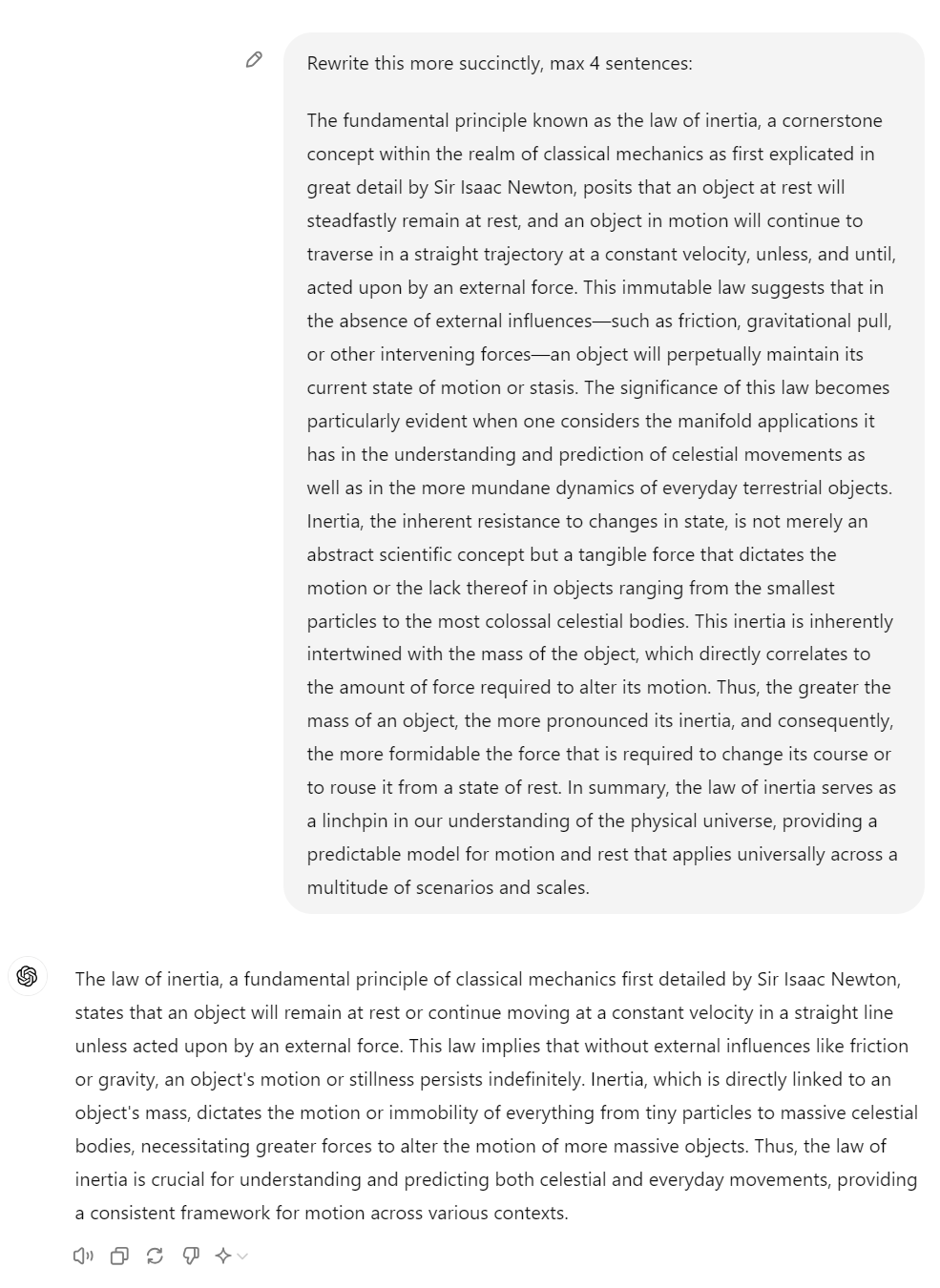
As compelling as these benefits are, they don’t necessarily mean anyone should create exclusively AI-generated content.
Human feedback, fact-checking, and manual editing can always ensure higher quality and improved accuracy.
Further reading: 15 Benefits of ChatGPT (+8 Disadvantages)
Limitations of Generative AI Tools
- May reflect biases or inaccuracies present in their training content: AI tools don’t always have the ability to identify or address these elements
- May not cite original sources or attribute concepts accurately: When the sources aren’t clear, further research may be difficult or impossible
- Offer insufficient transparency into their technology and methods: The average user may not know how a certain tool trains or generates content
- Can’t think independently or generate new ideas: Since generative AI tools train on existing data, they don’t have the capacity to create completely new content
- Lack first-hand experience and personal opinions: Generative AI tools can’t think for themselves, so human review and experience can improve accuracy and add expertise
Here’s what happened when we asked Notion AI to generate an opinion about the TV show Family Guy:
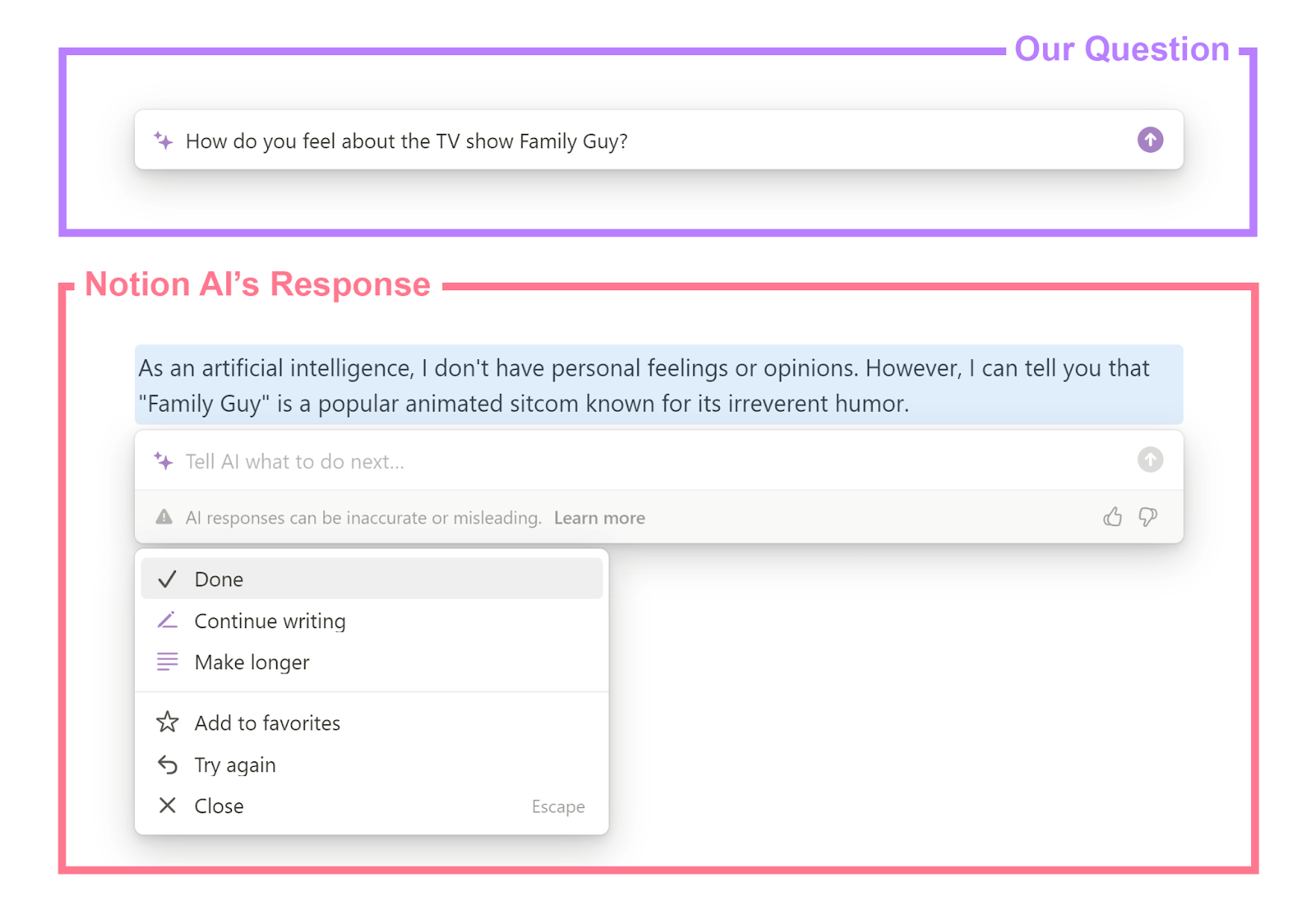
Although these limitations may seem daunting, they shouldn’t prevent you from using generative AI applications for efficiency.
Then, use your human intelligence to detect AI-written content bias, ethical considerations, and attribution issues. And tweak the content as necessary.
Further reading: AI-Generated Content: A Complete Guide to the Pros & Cons
Concerns Surrounding Generative AI
Although gen AI can certainly be used for good, it has the potential to create serious concerns.
As an example, deepfakes are digitally altered photos or videos that make the subject appear to be another person. One can use them maliciously to propagate false information.
Although deepfake detectors can increasingly identify images and videos that simulate another person, foolproof methods to alleviate these concerns don’t yet exist.
Instead, it’s essential to analyze content closely for anomalies. And adhere to security protocols to protect sensitive information.
Because generative models create content that emulates existing visual, audio, and textual patterns, they have the power to mislead.
Particularly, their ability to mimic human language can be used for social engineering. Which the European Union Agency for Cybersecurity defines as:
All techniques aimed at talking a target into revealing specific information or performing a specific action for illegitimate reasons.
For instance, gen AI models can encourage people to disclose sensitive information. Or compromise either personal privacy or their company’s security.
And as generative AI becomes more advanced, the infrastructure these models require may reach an unsustainable scale.
Keeping up with computer demands and coming up with the capital necessary to fund it is an ongoing concern for AI model developers.
A History of the Development of Generative AI
Generative AI has consistently made headlines since the launch of ChatGPT in November 2022 and other foundation models shortly after. However, the technology existed long before this date.
We list some major generative AI advancements in the table below.
|
A Brief History of Generative AI |
|
|
1947 |
Intelligent machinery In one of the first recorded references to artificial intelligence, Alan Turing used the term “intelligent machinery” in a research paper. The study explored whether machines could spot rational behavior. |
|
1950 |
Turing Test Turing developed the Turing Test, which evaluated conversations between machines and human brains to identify machine responses. |
|
1956 |
Dartmouth AI conference The Dartmouth Summer Research Project on Artificial Intelligence, considered the birth of AI, brought together AI experts. |
|
1961 |
ELIZA chatbot Joseph Weizenbaum developed the ELIZA chatbot, a psychotherapy program that could converse with humans. And one of the first examples of generative AI. |
|
1980s |
RNN architecture Several researchers advanced recurrent neural network (RNN) architecture. Furthering the development of this bidirectional artificial neural network. |
|
1997 |
LSTM networks Josef Hochreiter and Jürgen Schmidhuber invented long short-term memory (LSTM) networks, significantly improving the accuracy of AI models. |
|
2014 |
GANs and VAEs The development of GANs and VAEs dramatically advanced generative AI technology. |
|
2017 |
Transformer models Newly developed transformer models allowed gen AI systems to create natural language text for the first time. |
|
2018 |
OpenAI GPT OpenAI released GPT, a neural network that could generate human-like text and converse with users. |
|
2021 |
OpenAI DALL-E OpenAI introduced DALL-E to generate digital images from prompts through deep learning. |
|
2022 |
OpenAI ChatGPT, Midjourney beta OpenAI launched ChatGPT (also known as GPT-3.5), a transformer-based model that one million users adopted in only five days. Text-to-image generator Midjourney launched in beta the same year. |
What Does Generative AI Mean for the Future?
While generative AI’s timeline is relatively long, many significant developments have happened in a few short years.
Given this rapid evolution, it’s reasonable to expect that gen AI will continue to develop quickly.
So, what will AI look like in the future? And how could it affect your industry?
Here are a few developments to monitor:
- Increased adoption of generative AI tools: In many industries, companies are already pressuring leaders to implement AI tools. A Qualtrics survey of customer experience professionals revealed that 75% feel the pressure to use generative AI for business.
- More advanced AI prompts: The more companies adopt generative AI strategies, the more advanced their prompting skills are likely to become. With extensive testing, users will probably develop more specific, nuanced prompts for producing higher-quality content.
- Higher volume of AI-generated content: As more individuals and business processes use gen AI tools, the amount of AI-generated content will increase. Harvard Professor Latanya Sweeney predicts 90% of online content creation will no longer be by humans.
- Improved AI detection: As AI evolves, AI detection tools may become more sophisticated. Increasingly advanced tools will better address issues with cybersecurity, deepfakes, and other growing concerns—potentially making AI content more credible.
Further reading: 15 Must-Watch AI Trends to Empower Your Business in 2024
Use Advanced AI Tools to Improve Your Content
Whether you’re just getting started with generative AI or looking for ways to level up your AI skills, you need the right tools at your disposal. Like Semrush’s AI-powered digital marketing tools.
Create better content faster with ContentShake AI, compose and optimize content with SEO Writing Assistant’s AI features, and design smart ad creatives with AdCreative.ai.
Sign up for a free Semrush account and try its generative AI tools today.

